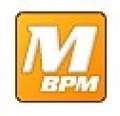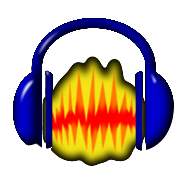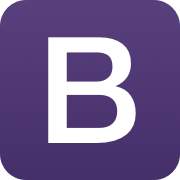Music Therapy on Stress Reduction For University Students
Info: 11995 words (48 pages) Example Dissertation Proposal
Published: 1st Dec 2021
Tagged: Psychology
Abstract
In Hong Kong, students have lots of homework and quizzes. In 2015-2016, there has a series of students suicide cases happen. This reflects the stress level of students are quite high. Students are need to relief stress. Music therapy is an effective way to relief stress and relax your mind during study.
Music therapy is accepted and common in foreign countries. However, music therapy is not common in Hong Kong. Also, the fees of music therapy session is too high for students. Although there has a lot of songs claimed to be relax, the songs has not verified or proved to be relaxed.
This project is to provide a music therapy platform to university students to relief stress and let university students know more about music therapy. In the project, the music is being analyzed before putting to the platform. The analysis is conducted through different analysis tool. Users can listen music and play music therapy activities through our platform and give feedback about the platform.
Contents
Click to expand Contents
1. Introduction
1.1 Background
1.2 Problem Statement
1.3 Objectives and Outcome
2. Literature Review
2.1 What is Music Therapy?
2.2 What is stress?
2.3 Soft music helps reduce stress
2.4 Effect of music on stress
2.5 Effect of slow tempo music
2.6 Effect on music tempo manipulation
3. Implementation Approach
3.1 Analyze music
3.2 Build the website
3.3 Music Treatment
3.4 Questionnaires about the website
4. Music Selection
4.1 Objective
4.2 Music Analysis
5. System Design
5.1 Users Type
5.2 Functional Requirement
5.3 Preliminary System Design
5.4 Sequence Table
5.5 Hardware & Software Requirement
5.6 Programming Language
6. Implementation
6.1 User
6.2 Admin
7. System Testing
7.1 Unit testing – User System
7.2 Unit Testing-Admin System
7.3 Integration Testing
7.3 Browser Testing
8. Evaluations and discussion
9. Limitations
9.1 Professional
9.2 Limited mental problems are included
9.3 Limited Song Selection under Copyright Restriction
10. Further development
10.1 Add more songs
10.2 Include more problems
10.3 Develop Mobile Application
11. Summary
12. References
Appendix
Table of Figures
Figure 1. Drum Kit(left) and Electric Guitar(right) use in Hard Rock
Figure 2. Harp(left) and Flute(right) use in New Age music
Figure 3. Pop song Charlie Puth-One Call Away)
Figure 4. (Hard Rock)ACDC-Highway To Hell
Figure 5 New Age(Calming Sea)
Figure 6 Folk Music (Three Kites Cycling)
Figure 7 Instrumental Music (Piano Music)
Figure 8 – Song BPM Analysis Result
Figure 7 Air.mp3
Figure 8 Scarlet_Sails.mp3
Figure 9 User Case Diagram
Figure 10 -Database Diagram
Figure 11 System Diagram
Figure 12 Sequence Diagram for users
Figure 13 Sequence diagram for admin
Figure 14 Home Page
Figure 15 Music Improvisation
Figure 16 Drawing Panel
Figure 17 Puzzle
Figure 18 About Page
Figure 19 Assessment Page
Figure 20 Music Player Page
Figure 21 Music Player
Figure 22 Profile
Figure 23 Feedback Page
Figure 24 Register Page
Figure 25 View Music
Figure 26 Delete Music
Figure 27 Edit Music
Figure 28 Insert Music
Figure 29 View Feedback
Figure 30 Delete Feedback
Figure 31 Login
Figure 32 Question 3
Figure 33 Question 4
Figure 34 Question 5
Figure 35 Question 6
Figure 36 Question 7
Figure 37 Question 8
Figure 38 Question 9
Figure 39 Question 10
Figure 40 Question 11
List of Tables
Table 1 song table
Table 2 assessment table
Table 3 admin table
Table 4 user table
Table 5 response table
Table 6 Software Requirement
Table 7 Programming Language
Table 8 Music Player Component
Table 9 Test Case for Register Page
Table 10 Test Case for login (Correct)
Table 11 Test Case for login (Incorrect)
Table 12 Test Case for profile
Table 13 Test Case for changing password
Table 14 Test Case for account deletion
Table 15 Test Case for assessment
Table 16 Test Case for music player
Table 17 Test Case for feedback
Table 18 Test Case for view Music
Table 19 Test Case for music Insertion
Table 20 Test Case for music deletion
Table 21 Test Case for music edit
Table 22 Test Case for view feedback
Table 23 Test Case for delete account
Table 24 Test Case for view account
Table 25 Test Case for Integration Testing
Table 26 Browser Testing
1. Introduction
1.1 Background
In 2015-2016, Hong Kong students consecutively committed suicide because of study pressure. Hong Kong students have tons of homework, exams and mid-terms. They may not find the ways to relief stress. During 2015-2016, 6 university students decided to end their life because of study pressure. Stress reduction for students is more imperative now. The stress from students are mainly from study. However, students with stress are tend to seek help online instead of finding social workers or calling hotlines.
In a survey about academic stress level and health outcomes among university students, using 230 college students from year 1 to year 3 in Hong Kong and mainland China. Participants are needed to answer the 23 items by rating each item in a 5-point Likert scale (1=never, 5=most of the time) to measure the five types of stressors that are frustrations, conflicts, pressures, changes and self-imposed stress. Hong Kong students (Stress score: 70.5) have significantly higher levels of stress than their mainland China students (Stress score: 67.5). This shows that the stress level of university students is high [9].
Music therapy has widely accepted as a mental therapy in different countries such as America, Australia, Canada and United Kingdom etc. Many studies have proved the music therapy is an effective measure to alleviate pressure and done experiences to prove that music therapy can decrease in cortisol level and heart variability.
1.2 Problem Statement
Lack of knowledge in Music Therapy
Many Students do not know music therapy. There have only few students understand how music therapy can benefit them. Students are usually listen music in online platform such as YouTube, Spotify etc. When they are stress, they usually seek help online. This system can promote music therapy and relief their stress.
Music Therapy is expensive to students
Music therapy is usually held by music therapists. Each session costs £40 which is quite expensive to students. Also, music therapy is a long-term treatment that is about 10 sessions. Students are hard to afford the music therapy.
Current relaxing music in online platform is not proved to be relax
Although there has a lot of music in YouTube for relaxation, the effectiveness of the music is questionable. There has a lot of relax music videos in YouTube but they are not verified to be relaxing music.
1.3 Objectives and Outcome
The aim of this project is to propose the idea of online platform of stress reduction for university students by providing soft music. Soft music is defined as a kind of music that has slow tempo and approximately 60-70 beats per minute (bpm).This project target is university students who have pressure on study. The web-based platform includes self-assessment, music player for users to reduce their stress. Also, it can allow users to interact with social media. The system can let users listen relaxing music through internet anytime and free of charge.
2. Literature Review
2.1 What is Music Therapy?
Music Therapy is the clinical and evidence-based use of music interventions to accomplish individualized goals within a therapeutic relationship by a credentialed professional who has completed an approved music therapy program [1].Music therapy is recognized as an established allied health profession that uses music to facilitate therapeutic processes [2]. Music therapy is a research-based practice and profession in which music is used to actively support people as they strive to improve their health, functioning and wellbeing.
2.2 What is stress?
Stress is the feeling we have under pressure. The stresses exists when we think that we are overloaded and we may not cope with the pressures. Stress is currently defined as the non-specific response of the body to any demand for change by Hans Selye in 1936. Physically, stress will cause rising blood pressure, more rapid breathing, rising heart rate, weak immune system, tense muscles and insomnia. Psychologically, stress will make you feel insecure, sad, fatigue, restless, angry and depressed.
2.3 Soft music helps reduce stress
A journal states that “Listening to classical music increases heart rate variability, a measure of cardiac autonomic balance (in which increased levels reflect less stress and greater resilience), whereas listening to noise or rock music decreases heart rate variability (reflecting greater stress) [4].Another review indicates that listening to ‘relaxing music’ (generally considered to have slow tempo, low pitch, and no lyrics) has been shown to reduce stress and anxiety in healthy subjects [5]. The study shows that they found that sedative music contrasted with simulative music had a higher effect on decreasing tension and increasing relaxation. Moreover, listening to preferred music resulted in reduced tension compared to listening to unpreferred music, while there was no significant difference in relaxation level between listening to preferred and unpreferred music [6].
2.4 Effect of music on stress
Four studies evaluated the effect of music on patient stress by measuring various blood indicators. Cortisol was the most commonly measured stress indicator, and one study reported a significant reduction in blood Cortisol levels. Other stress indicators included blood glucose, prolactin, and catecholamine. One study reported a significant reduction in blood glucose [7]. The concentration of cortisol to relaxing music is lower than listening to nothing and the stress response of listening relaxing music is unchangeable and it indicates music can help to calm stress effectively [8]. Another study shows that all participants who experience new-age style music for 30 minutes, and played with a volume of 50 to 60 dB can reduce stimuli and more relaxed[12].
2.5 Effect of slow tempo music
A study shows that open-heart surgery patients who listened passively to experimenter-selected ‘soothing’ music (i.e., soft, relaxing, of 60 to 80 beats per minute, with a volume of 50–60 dB) for 30 minutes one day after surgery had higher levels of serum oxytocin compared to bed-rest alone [10]. The song’s rhythm begins with a beat of 60 beats per minute and then falls gradually to 50 beats per minute. Lyz Cooper, founder of the British Academy of Sound Therapy, believed that the heart rate slowly comes down to match the beat [11]. The two studies show that listening 60 bpm music has physically change and physically relax. A study also shows that slow tempo hastens the recovery of physical parameters like pulse rate and blood pressure[17].
2.6 Effect on music tempo manipulation
A research shows that tempo change and mood mediation are relatively affected. The research experiment shows that same pieces played at a faster or slower tempo will result in relaxed mood is better when playing slower piece [13]. Another study creates a study that six men and six women listen to one of two sound pattern conditions that are either increase or decrease in tempo. It shows that same music piece with decreasing tempo are consistently slower heart rate [14]. In a study, it shows that a single piece of music with two different version of tempo cause different blood pressure. The tension level tends to increase when the tempo increases while slowing down music tempo indicates rapidly decreasing levels of tension [15].
3. Implementation Approach
3.1 Analyze music
Music has different kind of music genres. In this project, relaxing music is the required music. Relaxing music is a kind of soft music which has slow tempo, low pitch, and no lyrics. The source of music will mainly come from YouTube. The method of music classification is to analyze bpm (beats per minute).BPM is used to measure the speed of music. The greater the bpm, the faster speed of the music. Also, the Also, the goal of this analysis is to obtain slow tempo music through analysis tool.
3.2 Build the website
After analysis, the music will be added to the website. Users can listen the music. However, repeated listening of music may lead to boredom and irritation because users can identify and predict sound and then users cannot benefit from the website. Therefore, there will have admin function that can change the pieces to prevent users lose interest on the music. Each music will last no less than 30 minutes. If original music exceeds the length and bpm, music will be adjusted. Also, there will have self-assessment about stress for users to know the stress level they are. Social media functions will be added in the website. Web programming languages such as HTML,PHP, JAVASCRIPT,JQUERY, CSS BOOTSTRAP and MYSQL are used in the website. A user-friendly and simple interface will be built.
3.3 Music Treatment
The aims of the music treatment is to relief stress to students.
First, music improvisation is designed for user to improvise and then through the process, they can relief the stress. Music improvisation is a common music therapy activity to calm down users’ mood and release tension. According to study, music improvisation is effective for reducing stress[16]. Drawing and playing puzzle that can relax stress will be also implemented. This music therapy activity will let user more comprehensive understanding more about music therapy and have activities to do while listening to music.
Second, the tempo manipulation treatment will be used as the tempo can affect the tension and heart rate. The above research shows that tension can be lower if the tempo is slower. Therefore, the higher the stress level is, the slower the tempo of the music it should be.
3.4 Questionnaires about the website
There will have evaluation form in the website. After building the website, users can give their rating and comments in the form. The form is use for improvement of the website. By collecting users’ feedback, the website can use the feedback to update the website. The comments will be recorded and used for user friendliness enhancement.
4. Music Selection
4.1 Objective
The objective of song analysis is to filter the music before putting into the music player. The target of music selection is less than 120 beats per minute non-lyrical soft music. The volume level should be less than 80dB.The duration of the music will be no more than 30 minutes in length. The selection is first start from music genre, then bpm, and then spectrogram and waveform.
4.2 Music Analysis
The music analysis is to choose the slow tempo and low frequency music. The music selection will have three procedures. First, different music genre will be analyzed based on waveform and timbre to narrow down the selection process and increase efficiency. Second, 80 music samples are selected to go through the bpm analysis. Third, the spectrogram analysis will narrow down the music to 30. The whole process aims to provide high quality and most suitable music for users to listen.
4.2.1 Timbre Analysis for music genre
The timbre of an instrument determines the middle part of the music. Different musical instruments can create different level of amplitude. For example, hard rock is constructed by electric guitar, bass guitar, drums etc. The attack of a hit on the drums is strong. The attack and decay of a plucked electric guitar string can create a large sound. With the combination of strong sound of musical instrument will create very loud and excited sound, in the waveform, the attack is throughout the whole song and the decay is very small proportion . Another example, new age music is constructed by piano, flute, harp and sounds of nature. The attack is much softer-sounding. The timbre of these kind of instruments are smooth and soft. The attack is given only a steady rise on the amplitude and the decay is throughout the whole song. Therefore, a smooth and soft timbre of the song selection is a must. In the below figure, the two figures show the drum kit and electric guitar. Another two figures show the flute and harp.
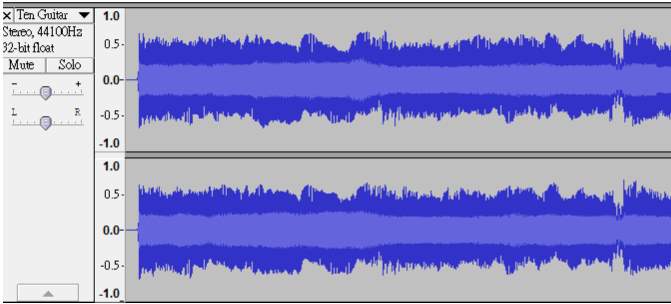
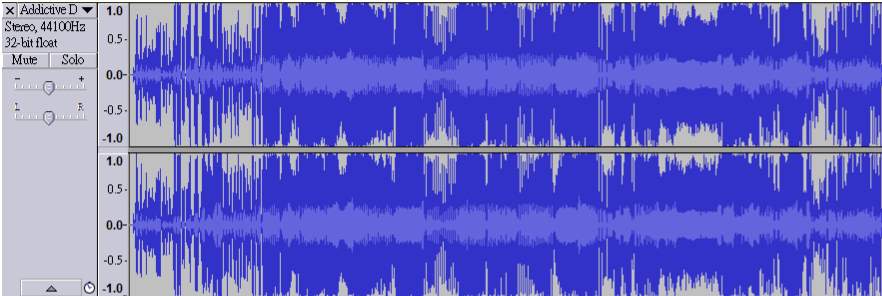
Figure 1. Drum Kit(left) and Electric Guitar(right) use in Hard Rock
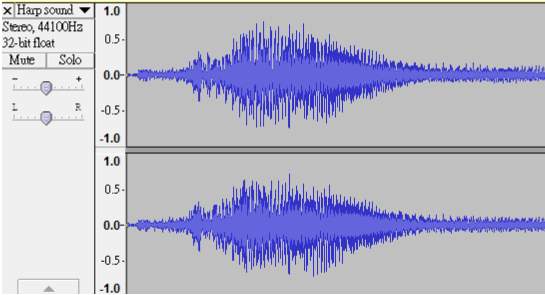
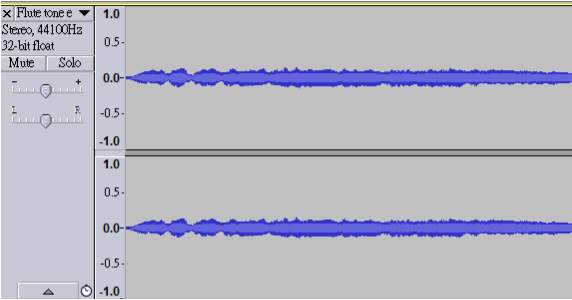
Figure 2. Harp(left) and Flute(right) use in New Age music
4.2.2 Analysis By Waveform for music genre
The songs can be analyzed by waveform. Waveform can be formed by showing signal such as wave moving. The waveform can be shown using Audacity. The waveform width is the time. The waveform height is the amplitude.
Case 1 - Pop Song

Figure 3- Pop song(Charlie Puth-One Call Away)
The amplitude of the song is increasing from the beginning and stay in a high level until the end of the song . The wave, indicated in blue color almost covers the whole graph. The peak is in a high level. The decay or the ending of the song is ends in a sudden short way.
Case 2 - Hard Rock Song

Figure 4 - (Hard Rock)ACDC-Highway To Hell
Compared to case 1, the amplitude of the song are much higher. The blue wave part has larger than case 1.The whole song is very intense and in a high energy level. The starting point of the music element is very high onset level after a constant low amplitude in the very beginning.
Case 3 - New Age Music

Figure 5 - New Age (Calming Sea)
Compared to the above cases, the amplitude of the song is much slower than the other songs. The energy level is very constant and stable. The rhythmic pattern is very repetitive. The whole song is in a non-intense level.
Case 4 - Folk Music
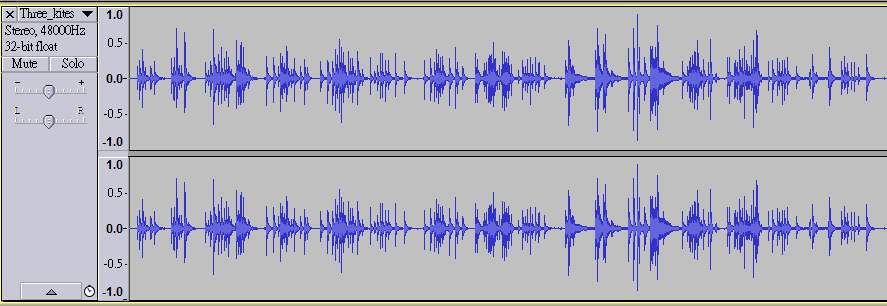
Figure 6 - Folk Music (Three Kites Cycling)
The folk music shows the low amplitude and low intense level. The music genre is soft .
Case 5 - Instrumental Music
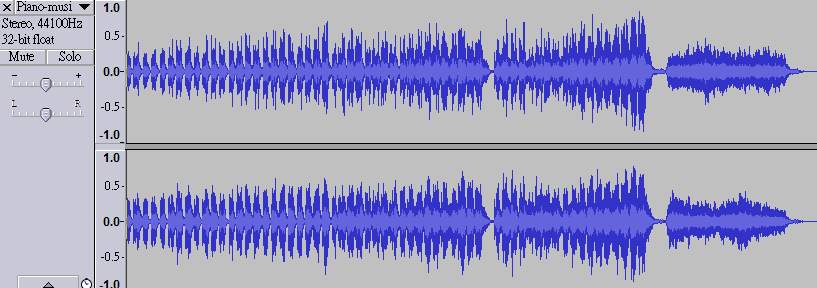
Figure 7 - Instrumental Music (Piano Music)
The instrumental music is showing the piano music. The music is not intense and the music genre is soft.
4.2.3 Analysis using bpm
Beats per minute is a measurement of the music tempo. The faster the tempo is, the higher the bpm is. The 50 pieces of music is analyzed from the software bpm counter. The cut-off line is in less than 98 bpm. It is based on basic Italian tempo marking. It defines slow tempo in less than 98 bpm. The following diagram extracts from BPM Counter:
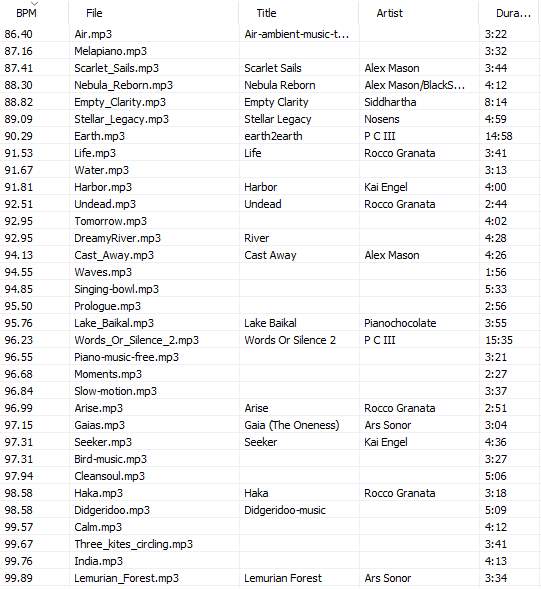
Figure 8 – Song BPM Analysis Result
The bpm analysis result shows that the range of 80 samples of music is from 86.40 to 163.64 bpm. The difference is quite large. The percentage of music selected in first phase is 54%. It shows that most songs are belong to music genre. The music analysis is generated by BPM counter which is a bpm analyzer software.
4.2.4 Analysis using spectrogram
Spectrogram is to measure spectrum of frequency in sound and fundamental frequency and amplitude in 60-80dB. This software uses Fast Fourier Transform (FFT) convert the signal from its original domain. The algorithm uses symmetry that reducing runtime from O(n2) to O(n log n). The higher decibel the music is, the louder the music is. The aim of this is to analyze the music whether it is under 80 dB. The music selection is using spectrogram generator software, Spek. For more sound, the following pictures are some songs extract from the suitable songs.
Case 1: Accepted
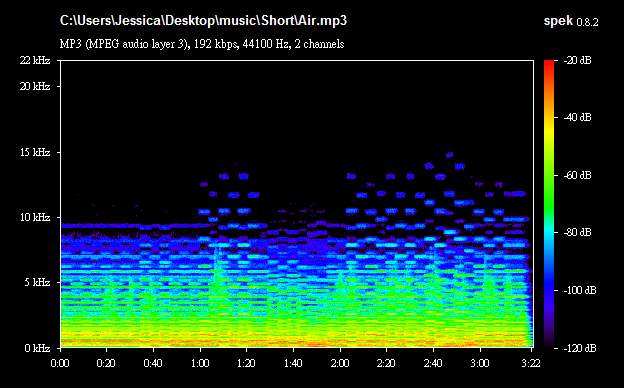
Figure 7 - Air.mp3 (New Age)
This song has low frequency and it implies low decibel on the song. As the green area represent 60 dB, the green proportion of the music is in high proportion which means low music intensity level. The spectrum density in blue area is sparse but the spectrum density in green area is concentrated.
Case 2: Not Accepted

Figure 8 Scarlet_Sails.mp3
Although this song is below 98 bpm, the blue area means high dB level has high proportional compared to green area. The song shows that it is about 20 kilohertz This means that the spectrum of energy of the music is high. The graph shows that the music may exceed 80dB range and nearly 100 dB.
In conclusion, the music is suitable for system when the decibel is not intense and strong. The range is within 60 dB to 80 dB. The more concentrated the blue area is, the stronger the music is.
The analysis result is narrow down to 30 songs in the selection process. The 30 songs are classified into different stress level according to the chronological order of bpm.
5. System Design
5.1 Users Type
There has two types of users, admin and visitors. Admin has more rights than common users. Admin can modify information while visitor only can register.
5.2 Functional Requirement
5.2.1 Listen music
Users can listen music in the system. There has a music list that has already in the system.
5.2.2 Do self-assessment
Users can do self-assessment in the system. The assessment is displayed in the assessment page and result of the self-assessment will be displayed.
5.2.3 Give Feedback
When the user finish using the system, users can give feedback to the system. The feedback form is available in the evaluation page.
5.2.4 Interact with social media
User can like and share the link of the system using their Facebook and Twitter account. The function is to promote the page and interact with users’ friends.
5.2.5 Login
User can login to the music system.
5.2.6 Register
User can register to the system
5.2.7 Change Password
User can change password in the system
5.2.8 Delete Account
User can delete account in the system.
5.2.9 Play Games
User can play music therapy activities in the system.
5.2.10 Admin-Feedback management
Admin can manage the feedback by viewing, deleting the feedback from the users.
5.2.11 Admin-Login
Admin can type user id and password to login to the system.
5.2.12 Admin-Account Management
Admin can view account information of user.
5.2.13 Admin-Music Management
Admin can upload, view, delete and edit music .
5.3 Preliminary System Design
5.3.1 Use Case Diagram
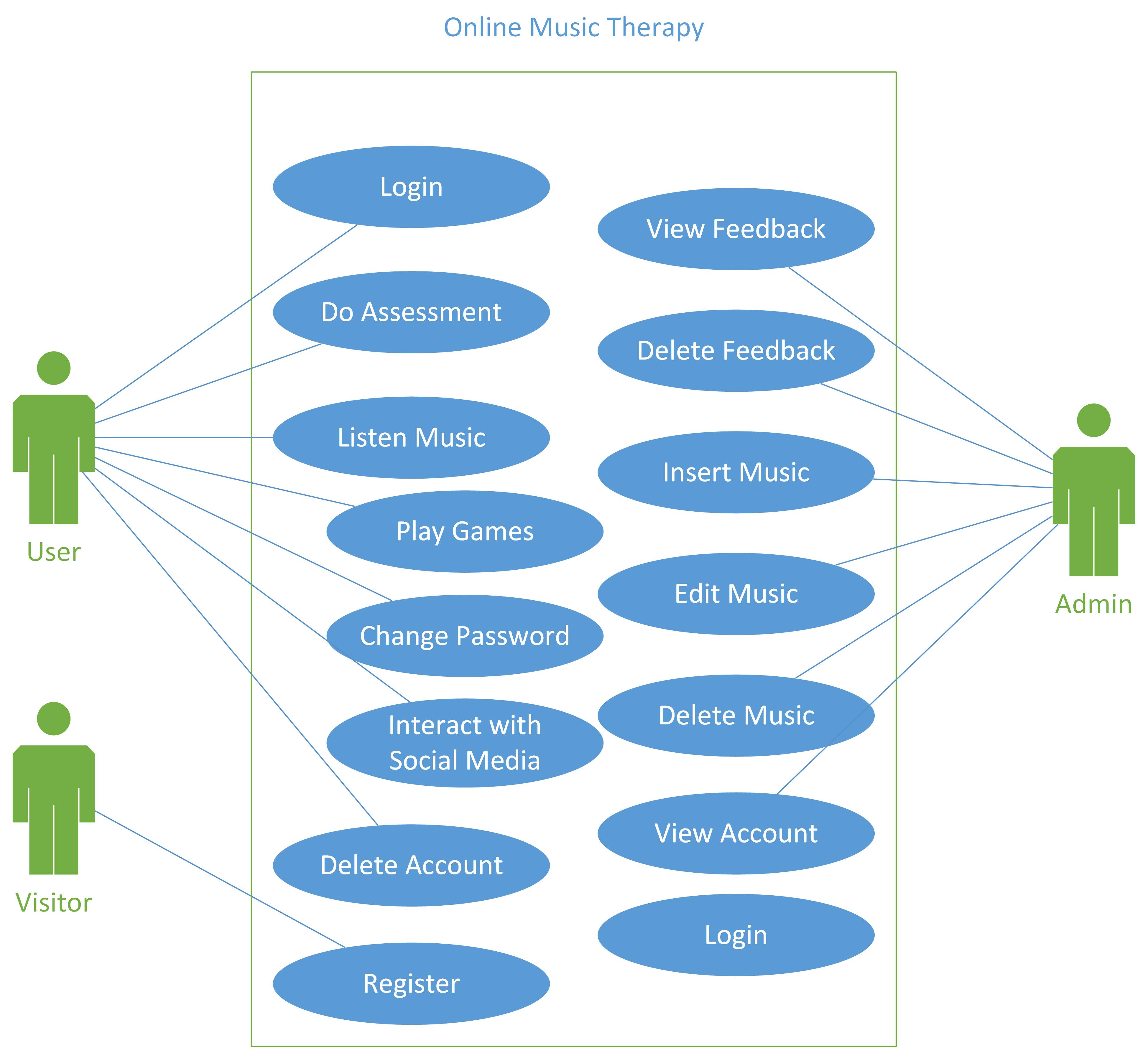
Figure 9 User Case Diagram
Users can login, do assessment, listen to the music and play game. Also, users can change password and delete account. Visitor has only right to register and then become a user. Admin has more rights than users and visitors. They can view, delete feedback and insert, edit and delete music. The user account can be viewed by admin.
5.3.2 Database Diagram
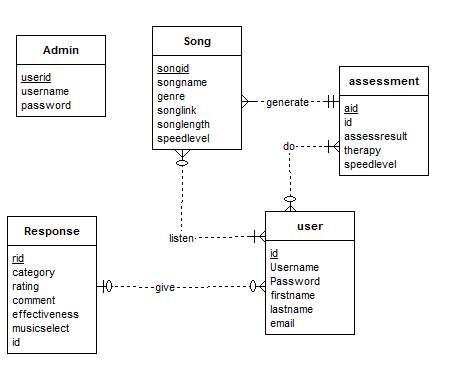
Figure 10 - Database Diagram
The relationship between song and user is zero to many and one to many respectively as at least one user can listen zero to many song. Also, the relationship between response and user is zero to many users gives zero or one response. The user does not require to give response. Also, one user can listen no song. But songs are required at least one user to listen. The user and assessment is linked in zero to many to one to many relationship.
5.3.3 Database Table
Song
| Attributes | Datatype | Primary Key | Description |
| songid | INTEGER | | The id of the song |
| songname | VARCHAR(45) | X | The name of the song |
| genre | VARCHAR(45) | X | The type of the song |
| songlink | VARCHAR(45) | X | The link of the song |
| songlength | VARCHAR(45) | X | The length of the song |
| speedlevel | VARCHAR(45) | X | The stress level the song belongs |
Table 1 song table
Assessment
| Attributes | Datatype | Primary Key | Description |
| aid | INTEGER | | The assessment id |
| id | INTEGER | X | Foreign key references user |
| assessresult | VARCHAR(45) | X | The assessment result |
| Therapy | VARCHAR(500) | X | The therapy |
| Speedlevel | VARCHAR(45) | X | The stress level |
Table 2 assessment table
Admin
| Attributes | Datatype | Primary Key | Description |
| userid | INT | | Unique identifier is automatically generated to the system. |
| username | VARCHAR(45) | X | The name of user |
| password | VARCHAR(45) | X | The password of the user |
Table 3 admin table
User
| Attributes | Datatype | Primary Key | Description |
| id | INTEGER | | The unique identifier of user |
| Username | VARCHAR(45) | X | The username |
| Password | VARCHAR(45) | X | The password |
| firstname | VARCHAR(45) | X | The first name of user |
| lastname | VARCHAR(45) | X | The last name of user |
| VARCHAR(100) | X | The email of user |
Table 4 user table
Response
| Attributes | Datatype | Primary Key | Description |
| rid | INT | | The unique identifier of response |
| category | VARCHAR(45) | X | The category of the response |
| rating | VARCHAR(45) | X | The user rating on the system |
| comment | VARCHAR(500) | X | The comment from user |
| effectiveness | VARCHAR(45) | X | The effectiveness of the therapy |
| musicselect | VARCHAR(45) | X | The music selection rating |
| id | INTERGER | X | The foreign key references user |
Table 5 Response Table
5.3.3 System Diagram

Figure 11 System Diagram
The system will have sent http request to the web server and application server will process the http request. Also, a database server is for storing the information and retrieve the data if receiving command.
5.4 Sequence Table
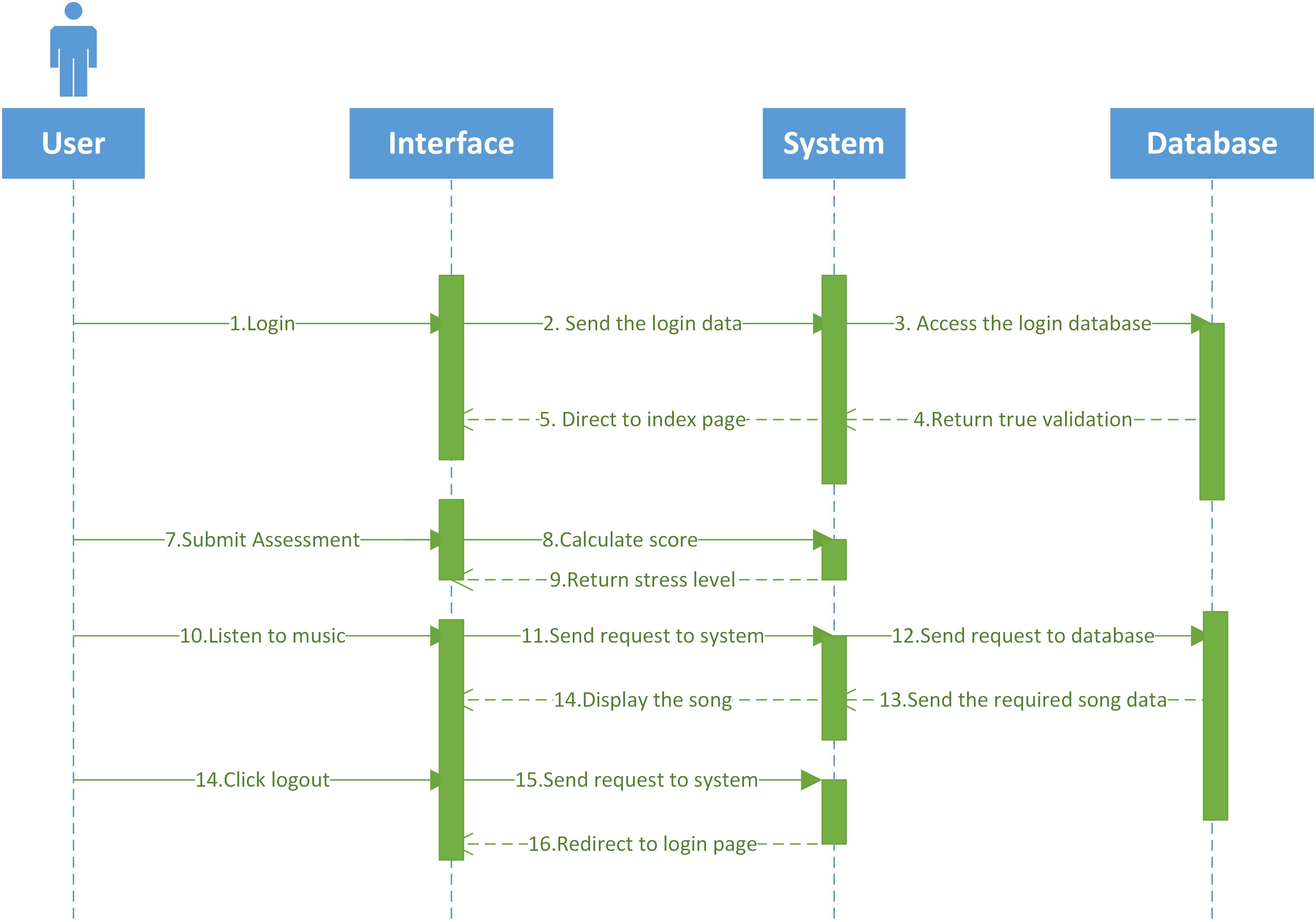
Figure 12 Sequence Diagram for users
The diagram shows the login process from step 1 to 5. The login process is assume the username and password are correct. The validation on the password are true. Then, users will login direct to index page. The next steps from 7 to 9 are assessment. After submitting assessment, the score will be calculated and display the stress level and therapy to users. For the next part (Steps 10-14) of music listening, the music will be shown required song and users can listen it. In the diagram, the system and interface will be transacted very frequently.
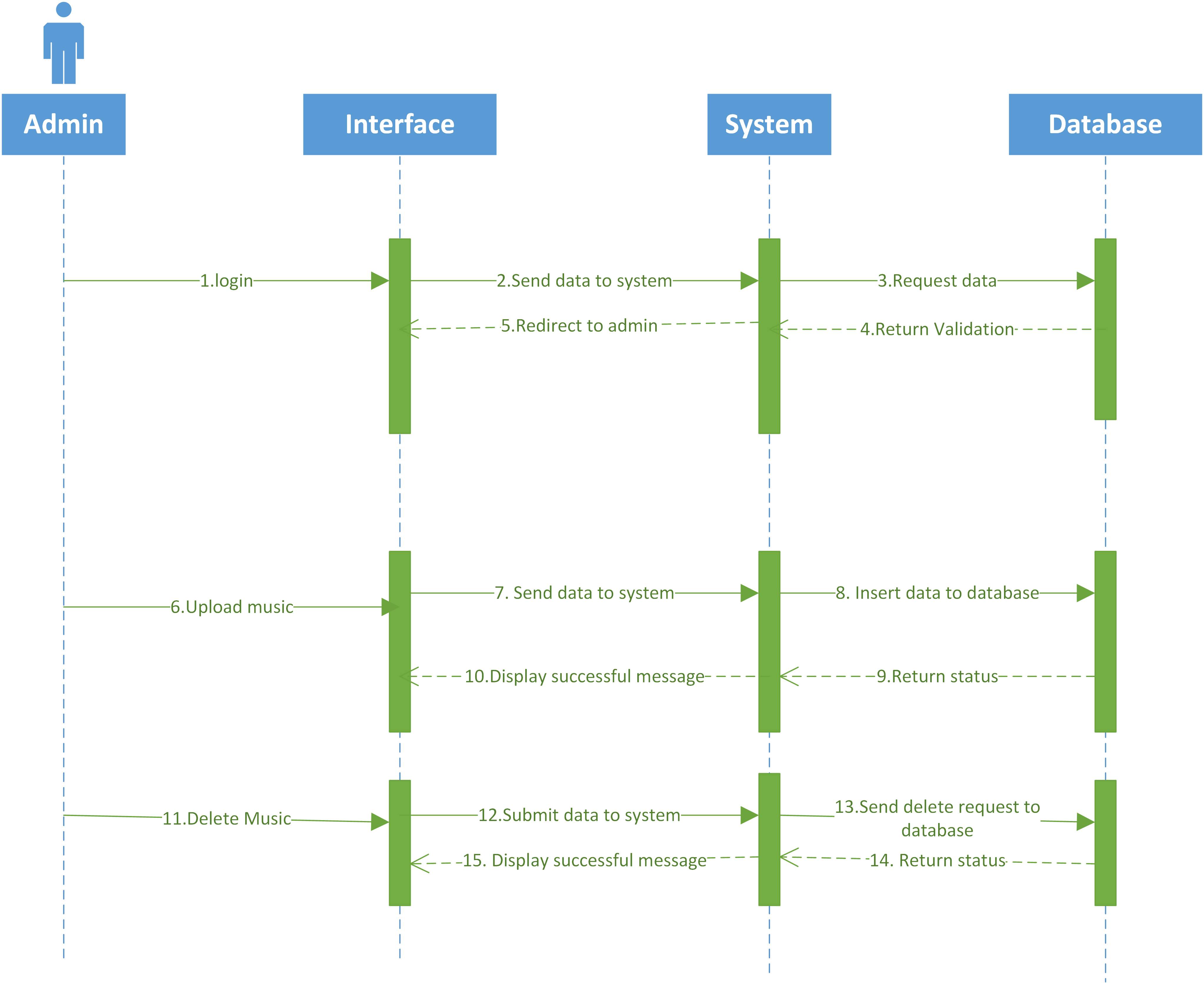
Figure 13 Sequence diagram for admin
In the diagram, it shows part of the admin functions. When admin submits login form, the interface will connect to system to request validation to the database. When the database validates, the admin index page will be redirected. For upload music function, the music will be uploaded to the system. The database will be requested by system to insert data to database. Then, it will display successful message to admin. The music deletion will be submitted data to system and then send delete request to database. Then database will perform the action and then inform the system. The interface will display the successful message to admin.
5.5 Hardware & Software Requirement
| Software | Description |
| Browsers
|
The browsers are used for website access and testing. |
| MYSQL
|
It is a database tool used for the web and store data. |
| BPM Counter
|
This software is to analyze the bpm of the music. |
| Audacity
|
This software is a digital audio editor and is to modify the music. |
 |
This software is a song analysis tool. It will generate spectrogram after putting a song. |
Table 6 Software Requirement
Hardware Requirement
Operating System: Windows 8 or above/Ubuntu 14.04.1 LTS or above/Mac OS X 10.1 Puma
Browser Requirement
Google Chrome 46.0.2490 or above & 46.0.1 or above
5.6 Programming Language
|
HTML
|
It is for creating web pages and web applications |
| Javascript
|
It is to program the behavior of web pages |
| Jquery
|
It is use in user interface interactions, effects, widgets, and themes built on top of the jQuery JavaScript Library. |
| CSS
|
It is use for decorate the web pages |
| PHP
|
It is use for interaction with backend database system. |
| BOOTSTRAP
|
It is use for building responsive webpage. |
Table 7 Programming Language
6. Implementation
6.1 User
6.1.1 Home Page
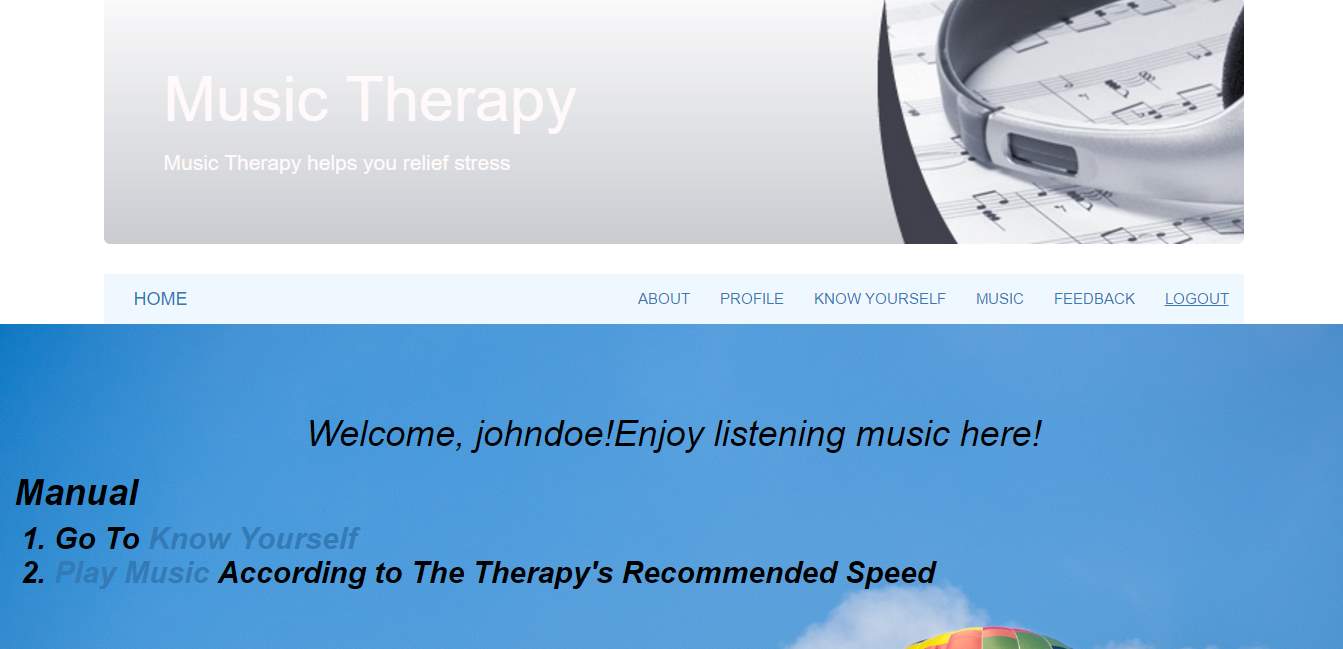
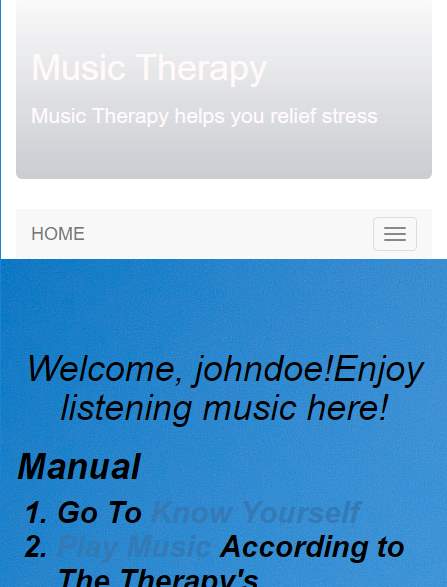
Figure 14 Home Page
After user successfully login, user can access the music therapy system. They can see the manual. In the manual, it embeds link in Know Yourself and Play Music. When users click either one of them, it will redirect to another page. Also, it has menu. When user hover the menu item, it indicates light grey color.
Music Improvisation
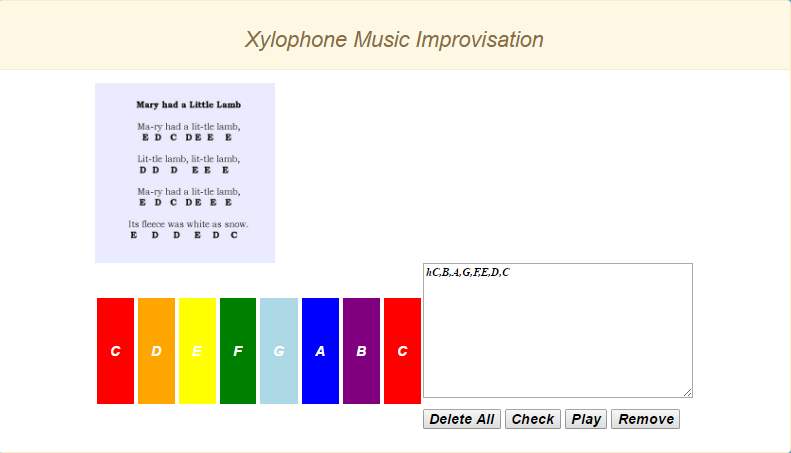
Figure 15 Music Improvisation
The music improvisation is at the lower part of the index page. User can click the xylophone button and sound will be played. User can play according to the photo of the music piece and then check if playing correctly. Another option is to improvise by clicking any button user want. The text area can display the note the user has played. If they don’t like the note that has played , they can click remove or delete all. After improvising, user can click play button to play the improvised piece.
Drawing Panel
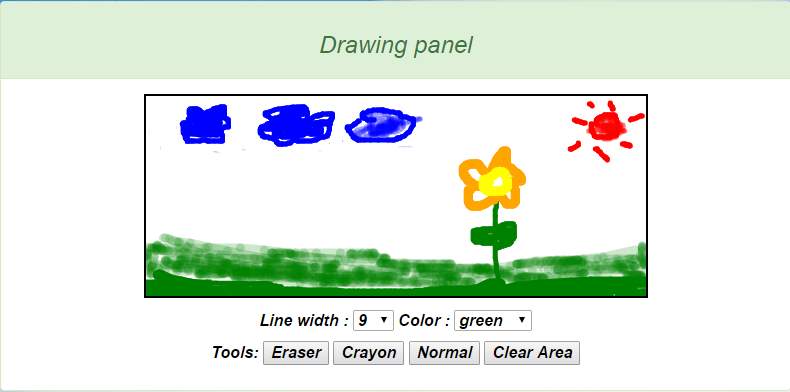
Figure 16 Drawing Panel
The drawing panel can choose line width and different color. The tools has eraser, crayon, normal and clear area button.
Puzzle
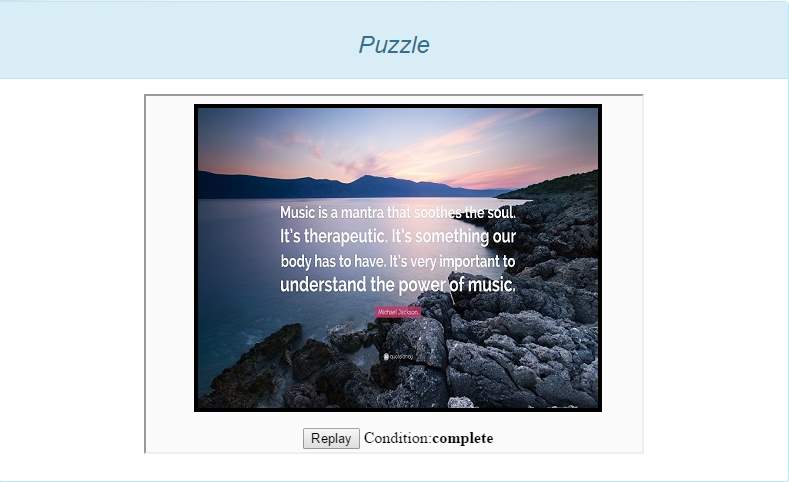
Figure 17 Puzzle
The puzzle is a picture with quotes. The button is a replay button and there has condition that states complete and incomplete.
6.1.2 About Page
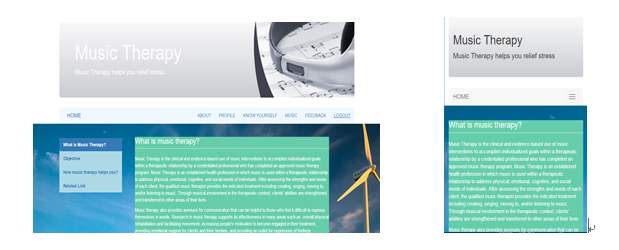
Figure 18 About page
The about page aims to let user understand more about music therapy. It has four sections. The first section is “What is music therapy?”. The second section is “the objective of the system”. The third section is “How music therapy helps you?”. The four section is the related link for further understanding. The menu bar always on the left side when user scroll down. Also, user can click different section and it will direct user to the section immediately.
6.1.3 Assessment Page
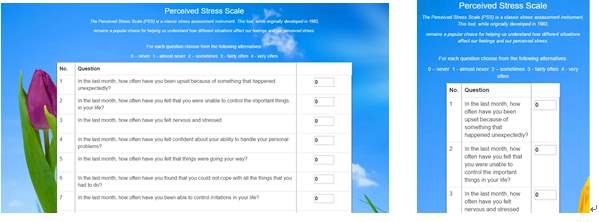
Figure 19 Assessment page
The stress assessment is according to professional sources. There has introduction about the assessment‘s effectiveness. There has instruction under the introduction. The user can input number from 0 to 4. After clicking submit, the score will be calculated and the stress level will be determined.
6.1.4 Music Player Page

Figure 20 Music Player Page
The music player page has carousel, music player and song list. The therapy recommendation is slower speed of music to 0.6. The music player will automatically slow down and indicate in the select option in speed. There has carousel that display relaxing images and quotes that are about relaxing and stress reduction. The song list is indicate on the right side of music player. User can click the music.
Music Player
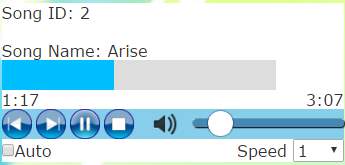
Figure 21 Music Player
| Component | Function |
| Play /Pause | When user click play button , the music player will immediately change to pause button. The music will be played. |
| Prev | When user click prev button, the music player will display previous song. |
| Next | When user click next button, the music player will display next song. |
| Stop | When user click stop button, the music will be stopped. |
| Volume slider | When user move the pointer, the volume will change. |
| Speaker | When user click speaker, the music will be muted. Click Again, the music will not be muted. |
| Speed | The speed can change the speed when selected. The option is 1, 0.8, 0.6. |
| Auto | When auto is checked, next song will be automatically play after the current song ends. |
| Bar | When user click the bar, the music will jump to the bar position when playing. |
Table 8 Music Player Component
6.1.5 Profile Page
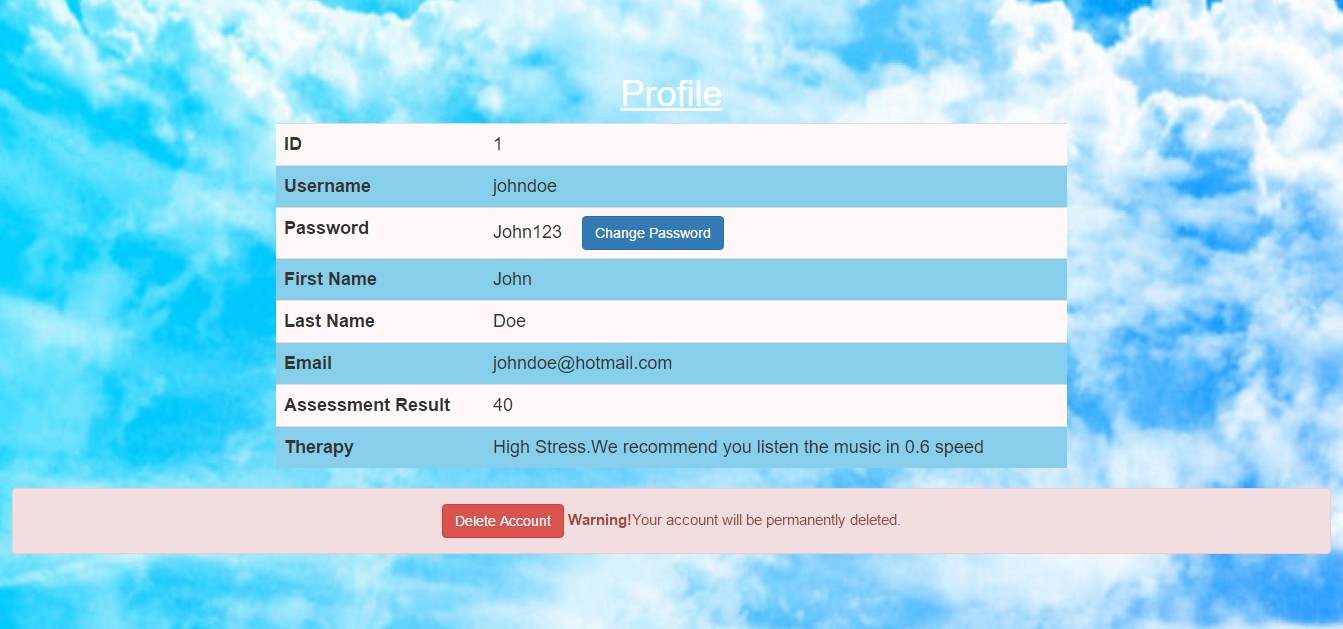

Figure 22 Profile Page
The profile can let user change password and delete account. Also, it shows all the details about in the profile. User can check the therapy, assessment result. The profile can show user id, username, password, first name, last name, email, assessment result, therapy. This page aims for letting user check the assessment result, change password and delete account.
6.1.6 Feedback Page
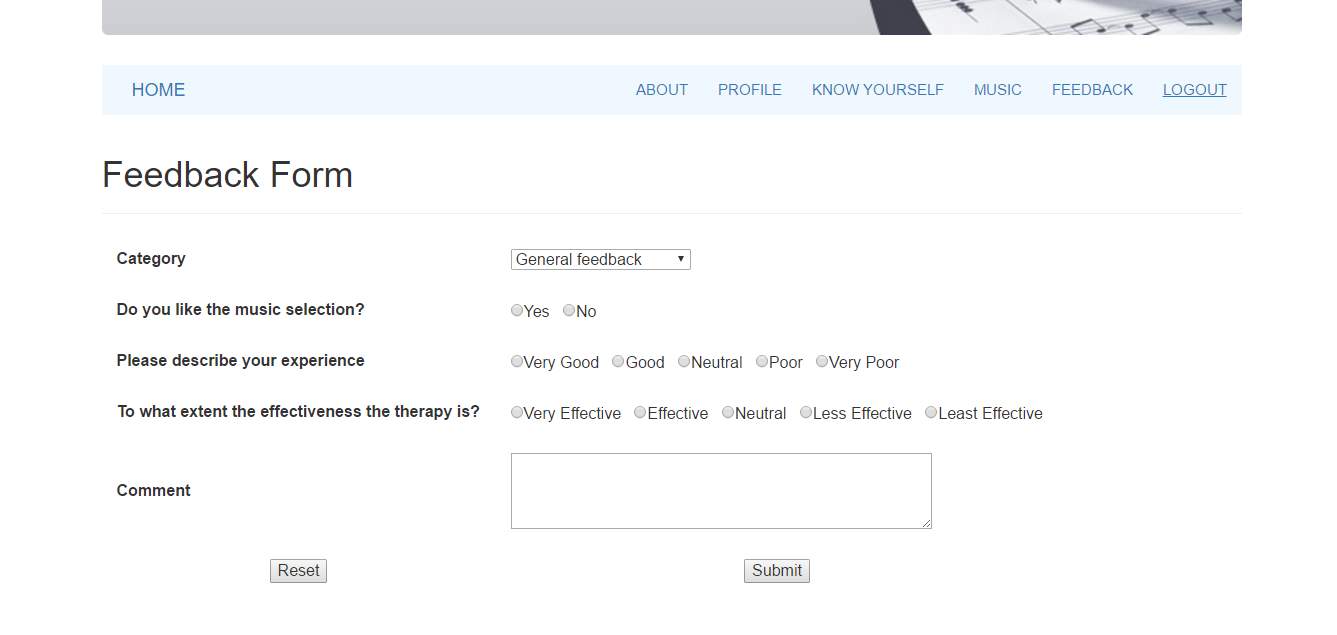
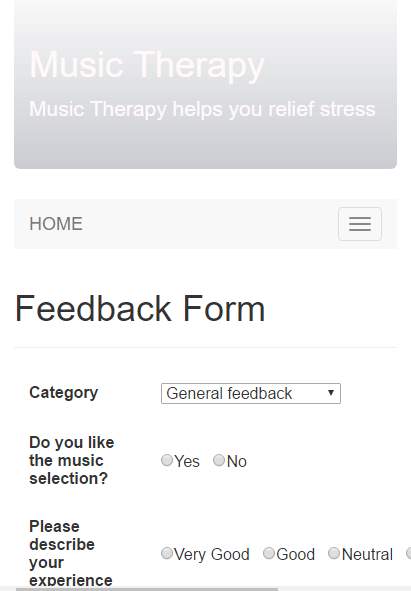
Figure 23 Feedback Page
The feedback page is available for users. The category has General Feedback, Bug Report, Website Improvement and Others. The user can choose the option from the three questions but the questions are shown in general feedback category. They can leave comment in the text area. In the bottom of the page, it has reset button and submit button.
6.1.7 Register Page
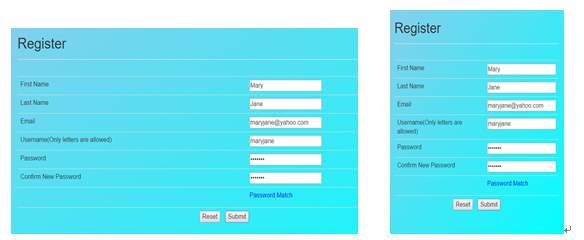
Figure 24 Register page
The register page is for visitor to register. The form is required user to input the information. There has case validation in the username part. Only number and letters are allowed. The password needs to be double confirmed. If it doesn’t match, it will need to input password again. The reset and submit function are available.
6.2 Admin
6.2.1 View Music
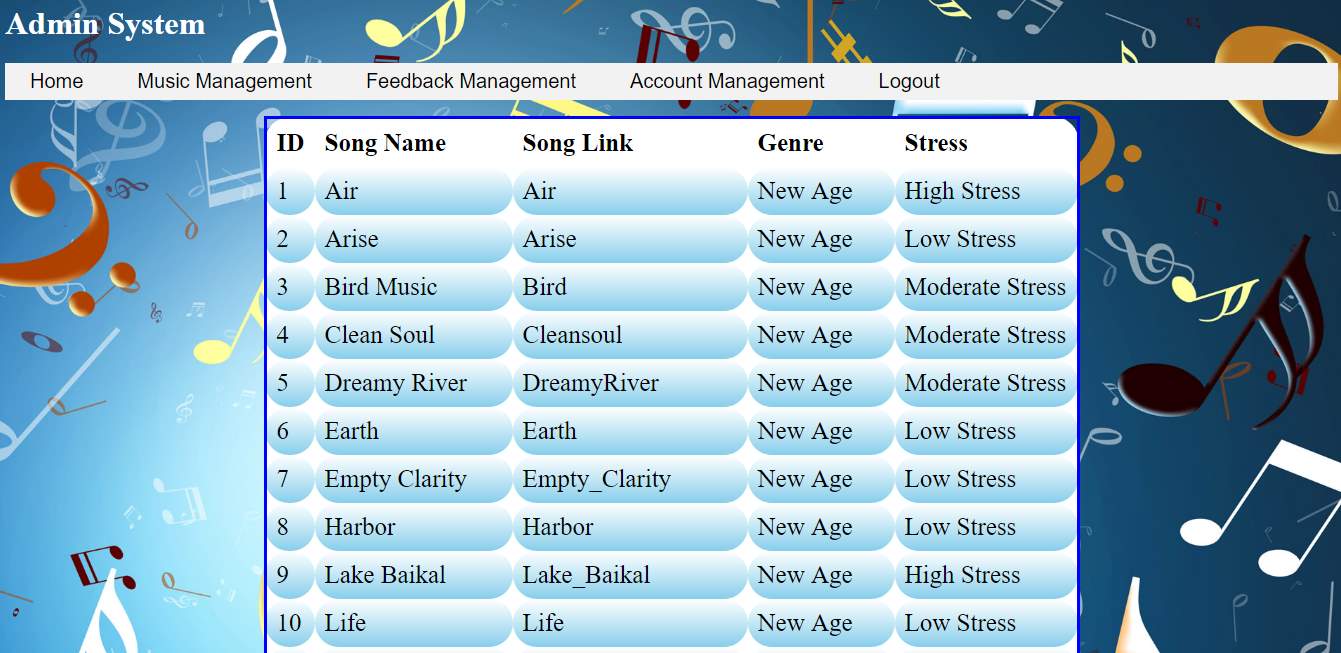
Figure 25 View Music
Admin can view the music to check what the songs have in the system.
6.2.2 Delete Music
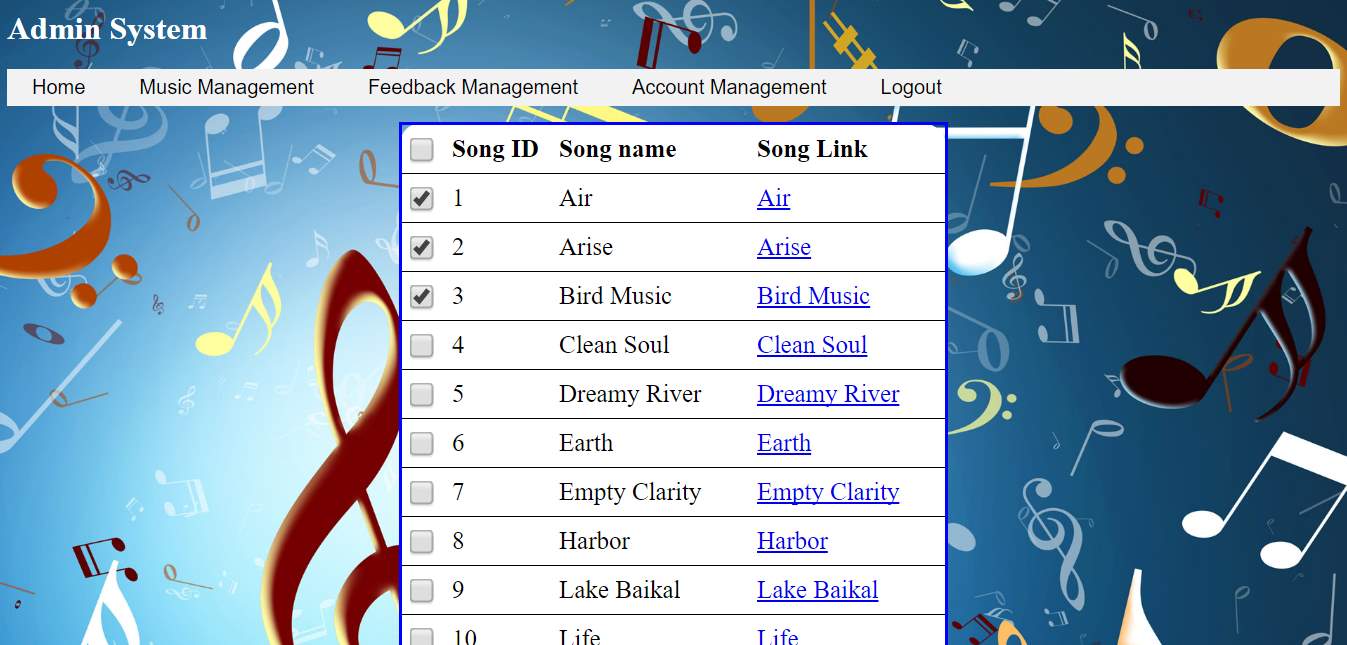
Figure 26 Delete Music
The delete music function is checkbox style. If the deleted music are checked, the song will be removed according to the checked box. Moreover, the message will be displayed deleted successfully.
6.2.3 Edit Music
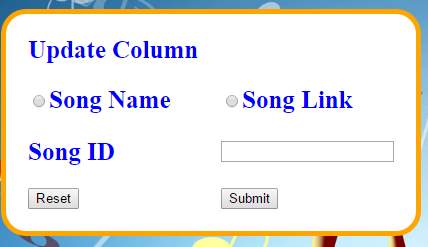
Figure 27 Edit Music
The music can be edited in song name and song link. If song link is clicked, the upload music button will be shown. The music can re-uploaded. The song id is a must column. After submit, the message will be shown successfully.
6.2.4 Insert Music
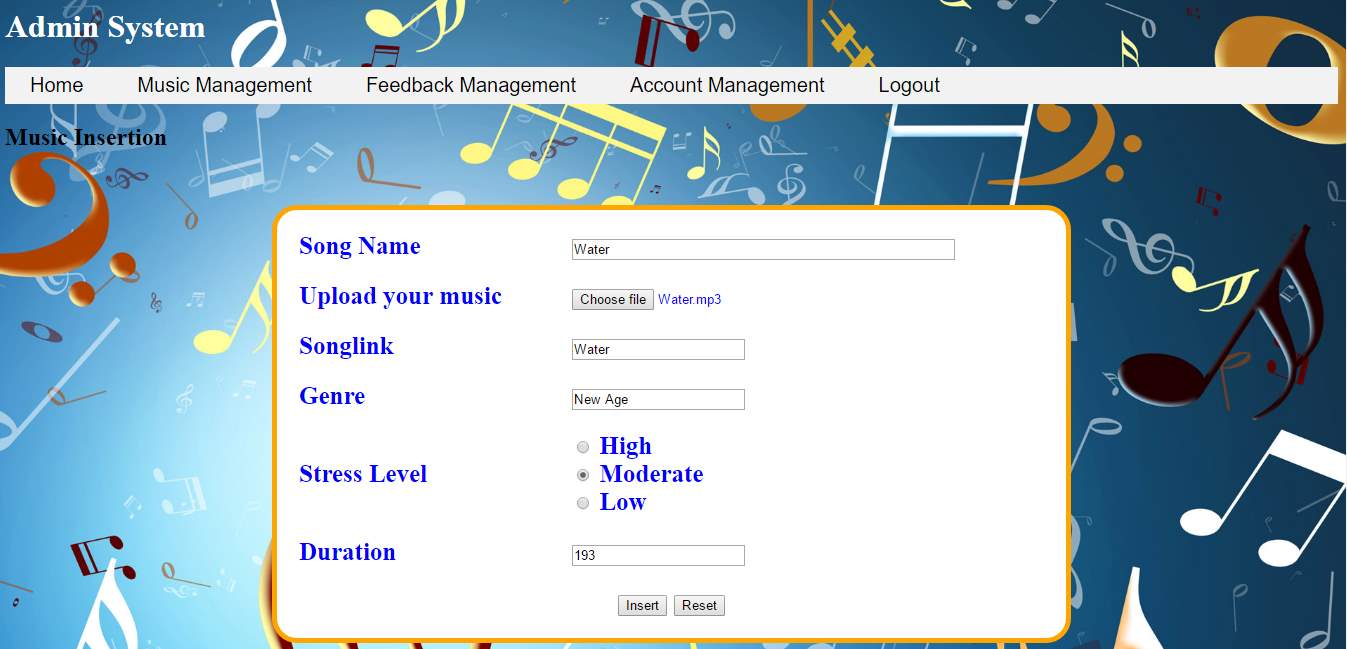
Figure 28 Insert Music
The music can be inserted. When admin uploads the music, the songlink column will be automated generated. The duration of the song will also be displayed immediately. Admin can type music genre and song name. The message will be shown after submission.
6.2.5 View Feedback
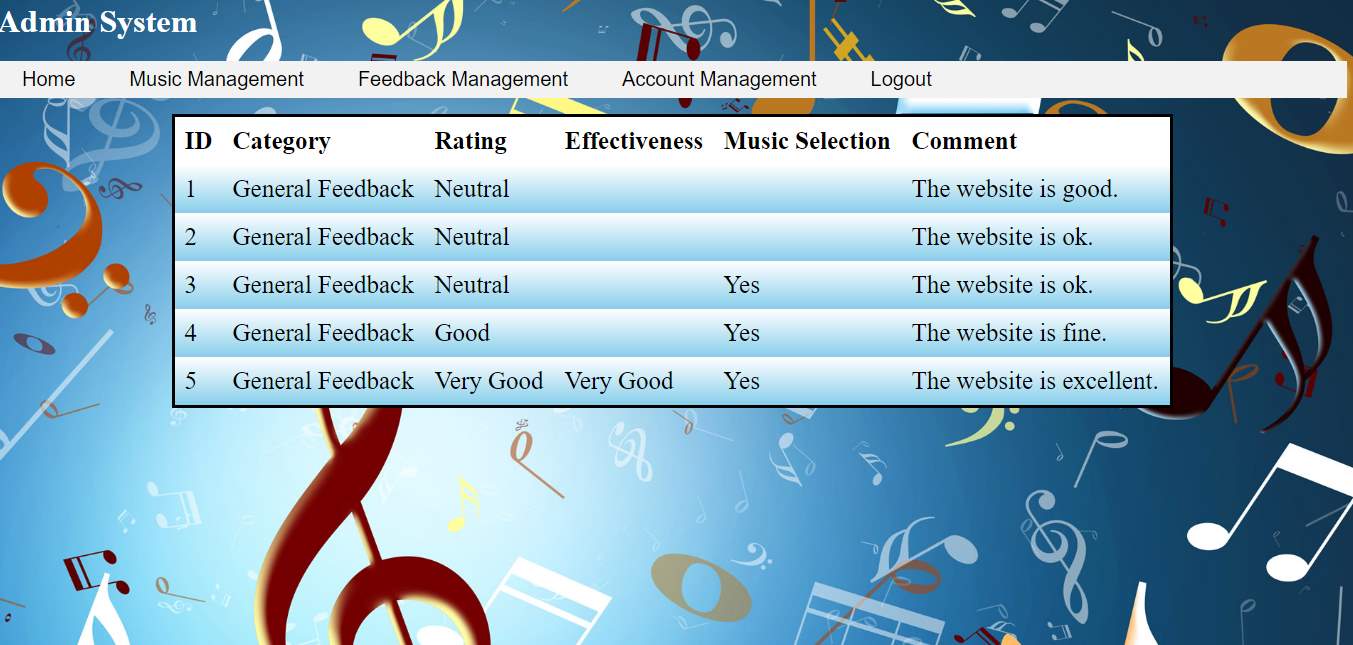
Figure 29 View Feedback
The feedback can be viewed so that admin can know how users feel about the website and the improvement. The feedback has classified into categories. The rating, effectiveness, music selection and comment will be shown.
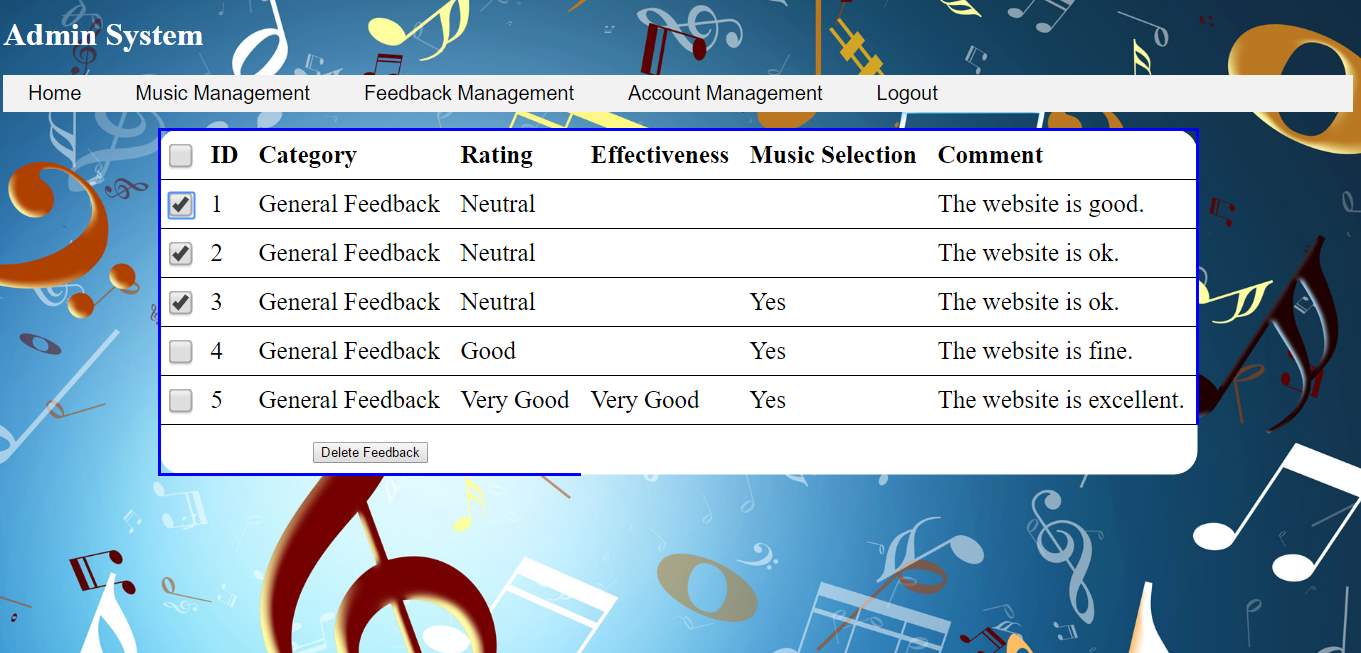
Figure 30 Delete Feedback
The delete feedback will be shown in checkbox format. For convenience, admin can check to all songs to delete. It will be much more convenient. After deletion, the message will be shown immediately. Check all function is available on the top of the checkbox column.
6.2.6 Login

Figure 31 Login
The login function is available in the system. If the user input correct password and username, it will be redirect to index page after submission.
7. System Testing
The system will perform unit testing and functional testing
7.1 Unit testing – User System
7.1.1 Register Page
| Test Case | Test Register function |
| Method | Input data into register form and click submit |
| Expected Result | The account is created. |
| Actual Result | The account is created. |
| Evaluation | Pass |
Table 9 Test Case for Register Page
7.1.2 Login page
| Test Case | Test Login function |
| Method | Input correct username and password and click submit.
Username: maryjane Password: Mary123 |
| Expected Result | The login page will redirect to index page. |
| Actual Result | After submit, the login displays message and redirect to index page |
| Evaluation | Pass |
Table 10 Test Case for login(Correct)
| Test Case | Test Login function |
| Method | Input wrong username and password and click submit
Username: John Password: John |
| Expected Result | The login page will display wrong message. |
| Actual Result | The login page displays wrong message. |
| Evaluation | Pass |
Table 11 Test Case for Login(Incorrect)
7.1.3 Profile Page
| Test Case | Test profile page |
| Method | Click profile page |
| Expected Result | The profile page will display the user data. |
| Actual Result | The profile page displays the user data. |
| Evaluation | Pass |
Table 12 Test Case for profile
| Test Case | Test password changing function |
| Method | Click profile page and then click change password, input old password(Mary123) and new password(Mary123123) and then submit. |
| Expected Result | The password change form will appear and password changes. |
| Actual Result | The password changes. |
| Evaluation | Pass |
Table 13 Test Case for Password Changing
| Test Case | Test account deletion function |
| Method | Click delete account button |
| Expected Result | The account will delete. |
| Actual Result | The account deletes. |
| Evaluation | Pass |
Table 14 Test Case for account deletion
7.1.4 Assess Page
| Test Case | Test assessment function |
| Method | Do assessment and then submit |
| Expected Result | The assesssubmit page will display and the assessment result will show. |
| Actual Result | The assesssubmit page will display and the assessment result will show. |
| Evaluation | Pass |
Table 15 Test Case for assessment
7.1.5 Music Page
| Test Case | Test music player function |
| Method | Click different button in music player |
| Expected Result | Play- The music will play.
Stop-The music will stop. Pause-The music will paused. Prev/Next- The music will go to previous and next music. Volume Control- The volume will go up or down. Speed –The playback speed can be changed from 1.0 to 0.6. Auto- The auto function will auto play to next song. |
| Actual Result | All results are as above. |
| Evaluation | Pass |
Table 16 Test Case for music player
7.1.6 Feedback page
| Test Case | Test feedback submission |
| Method | Click submit in the feedback |
| Expected Result | The feedback is submitted. |
| Actual Result | The feedback is submitted. |
| Evaluation | Pass |
Table 17 Test Case for feedback
7.2 Unit Testing-Admin System
7.2.1 Music Management
| Test Case | Test view music function |
| Method | Click View Music page |
| Expected Result | The music result is shown. |
| Actual Result | The music list is shown. |
| Evaluation | Pass |
Table 18 Test Case for view Music
| Test Case | Test insert music function |
| Method | Input data to music insertion form and then submit |
| Expected Result | The message for successfully insertion is |
| Actual Result | The music list is shown. |
| Evaluation | Pass |
Table 19 Test Case for music insertion
| Test Case | Test delete music function |
| Method | Click the required music to delete and then submit |
| Expected Result | A message for delete successfully will be shown. |
| Actual Result | A message for delete successfully will be shown. |
| Evaluation | Pass |
Table 20 Test Case for music deletion
| Test Case | Test edit music function |
| Method | Click the edit music form and then submit |
| Expected Result | A message for edit music successfully will be shown. |
| Actual Result | A message for edit music successfully will be shown. |
| Evaluation | Pass |
Table 21 Test Case for music edit
7.2.2 Feedback Management
| Test Case | Test view feedback function |
| Method | Click view feedback link |
| Expected Result | The feedback view page will be shown. |
| Actual Result | The feedback view page is shown. |
| Evaluation | Pass |
Table 22 Test Case for view feedback
| Test Case | Test delete feedback function |
| Method | Click the required feedback to delete and then submit |
| Expected Result | The delete successfully message will display. |
| Actual Result | The delete successfully message will display. |
| Evaluation | Pass |
Table 23 Test Case for feedback deletion
7.2.3 Account Management
| Test Case | Test view account function |
| Method | Click account view page and then submit |
| Expected Result | The view account page will be shown. |
| Actual Result | The view account page will be shown.. |
| Evaluation | Pass |
Table 24 Test Case for view account
7.3 Integration Testing
| Test Case ID | Test Case Objective | Test Case Description | Expected Result | Actual Result |
| 1 | Check link switching | Click every link on different pages | All links will redirect correctly. | Pass |
| 2 | Check register and login | Input data on register form and then submit. Go to login page and input login information and the click Submit. | The login is successfully. | Pass |
| 3 | Do assessment and play the music | Input assessment answer and then click submit. Then go to music player to play music. | The result and the treatment will be displayed. | Pass |
| 4 | Do feedback and logout | Input feedback and then submit. Then, click logout button | The account will be logout. | Pass |
Table 25 Test Case for Integration Testing
7.3 Browser Testing
The browser testing is performed by CrossBrowserTesting tool. The system supports Google Chrome, Firefox and Safari browser.
| Browser Version | Result |
| Firefox 49 | Pass |
| Firefox 50 | Pass |
| Google Chrome 56 | Pass |
| Google Chrome 57 | Pass |
| Safari 5.1 | Pass |
| Internet Explorer 10.1 | Layout Differences |
Table 26 Browser Testing
8. Evaluations and discussion
The evaluation is conducted after the participants use the website. The evaluation duration is about 45 minutes. After the evaluation, the questionnaires are given to participants for evaluation. There has 20 students participate in the evaluation session. The participants are university students in Hong Kong.
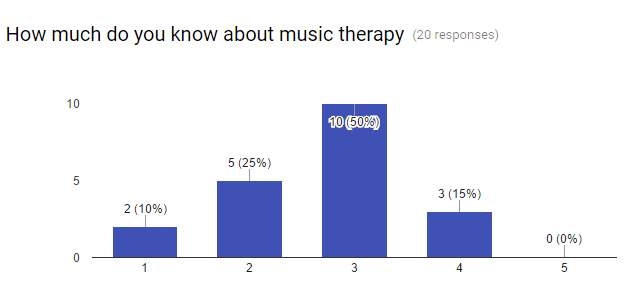
Figure 32 Question 3
The picture shows that 50% of the respondents doesn’t quite understand about music therapy. Only 15% of the respondents has more understanding about music therapy. No respondent thinks that they know so much in music therapy.
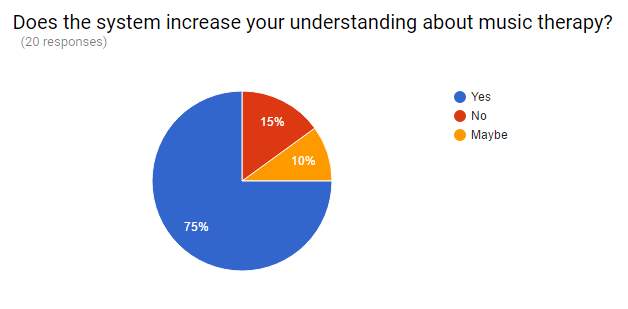
Figure 33 Question 4
However, with the information of the website, 75% of respondents are increase understanding of the website through the music therapy introduction , music recommendation . There has a small group of people(15%) that do not have gained understanding through website. Also, the 10% of people do not have clear understanding about music therapy.
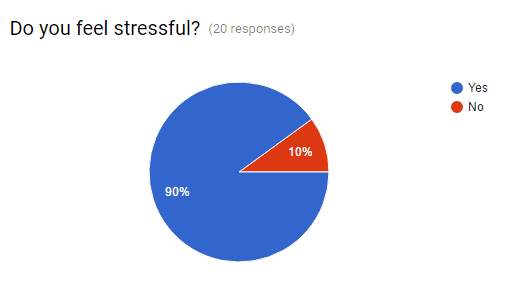
Figure 34 Question 5
To know the effectiveness of the system, respondents are needed to reveal their condition about stress. In the picture , it shows that 90% respondents suffer stress and only 10% of respondents have no stress. This can make the effectiveness of the system can be evaluated more accurately.
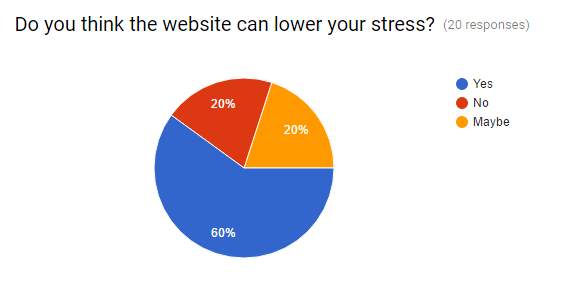
Figure 35 Question 6
60% of respondents think the website can help to relief the stress. It implies that they are uncertain about the music therapy effectiveness. About 20 % of respondents are uncertain about the music therapy. And the remaining respondents do not think the website can lower your stress. As the evaluation session duration is only once. The effect of the music therapy may be not affect the human relaxation so much. Also, the environment of the music therapy may be affected by the noise and human voice outside the therapy room area.
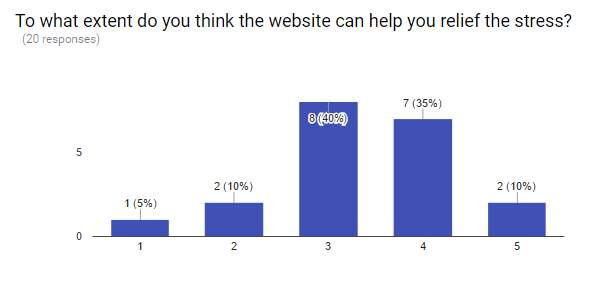
Figure 36 Question 7
40% has no certain preference on the question. The answer is neither helping nor not helping. 35% of respondents think that the website can help you relief the stress. The trend shows that the majority of respondents are regard the good effectiveness of the website.

Figure 37 Question 8
For the music selection, most of the respondents like the music selection. This proves that the music types are chosen well and the analysis of music selection has the contribution on it. As music selection can affect the arousal, therefore music selection likeness can affect the effectiveness of the therapy.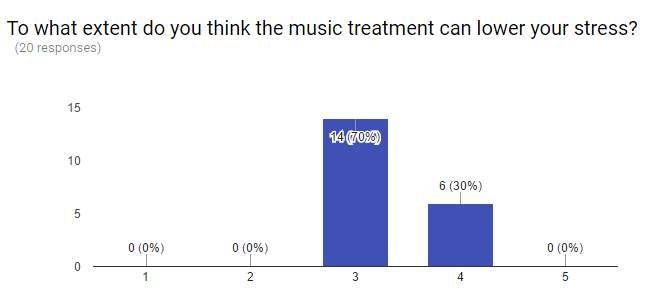
Figure 38 Question 9
70% of respondents thinks that music treatment can lower your stress moderately. 30% of respondents think that music treatment can lower the stress in a greater extent. No respondents are in extreme extent of like or dislike the music treatment. The reason behind is the evaluation session can demonstrate the concept of music therapy. Moreover, after the students understand more about the music therapy background. It shows that they are certain about the effectiveness of music therapy.

Figure 39 Question 10
The extent of the music selection likeness is mainly neutral. 55%of respondents has neutrally like the music selection. About 35% of respondents like the music selection. This shows that the music genres are not respondents mostly favorite. As university students usually love pop music, rock song that have high tempo, however, these types of music cannot relieve stress.
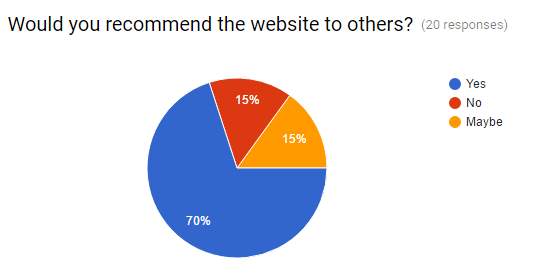
Figure 40 Question11
In conclusion, the therapy is effective and participants are know more about music therapy in the website. However, music selection may be obstacles for participants to continue to the treatment
9. Limitations
9.1 Professional
This music platform is not accredited by music therapists or any professional organization. The music platform‘s therapy is only based on researches about music therapy. This platform is aim for university students and let university students increase the understanding about music therapy. The platform doesn’t aim to provide professional therapists service. It is undoubtedly seeking music therapists can be more effective to alleviate stress.
9.2 Limited mental problems are included
The application is only focus on stress reduction. Other problems such as depression, insomnia and mental disorder etc. are not include in the application. Stress reduction is the important mental health problem nowadays. In this application, it focuses on stress reduction because of the increasing awareness. Due to limited time and scope, it is included only for stress reduction. Other mental diseases such as insomnia and mental disorder is not for this system. This system’s scope is aimed for stress reduction of university students. Therefore, all the content in the system is about music therapy and stress. Mental problems are limited included in the system.
9.3 Limited Song Selection under Copyright Restriction
The song selection is limited due to copyright and channels. The selection of song is from popular free video channel such as YouTube etc. Other songs libraries are needed to pay or do not have suitable songs to select. The song’s copyright restricts the song sharing. For the application, all songs are free. The song license is not known. The songs are selected by the free channel and the songs are needed to modify after selection. The song copyright is bounded by different owners’ copyright or agreement in different website. The song selection is also limited because of the cost. As the cost is limited, suitable songs cannot purchase and download from internet. Also, any download from internet without paying any cost may infringe copyright and may lead to law suit. However, some of the licenses on the songs are not clear and some of the licenses on the song are needed to ask permission of the owner. This increase the difficulties of music selection. Therefore, the song selection are selected from only websites that has clearly permitted others to use or has terms of Service and accept fair use. The fair use that is the purpose of using it is not for commercial purpose and the effect of the use upon the potential market for the copyright work. For all the songs selected, they fulfill the fair use of the song. The purpose is not commercial purpose and the effect of the use cannot harm the copyright owner’s ability to profit from his original work.
10. Further development
10.1 Add more songs
Due to copyright and limited channel for song selection, the song is only selected from free video channel. The songs are still in few. The songs can be included more music from different countries and suitable music genres. The number of songs can be larger. Songs can be added from other paid channels or websites. Songs such as traditional instrumental music and oriental folk music can be included to attract more users.
10.2 Include more problems
Not all mental illnesses are included in the website. These problems are needed to aware nowadays. Mental illnesses are needed to concern. Stress problem is only included in the website. In the future, the website can include more problems in the future, such as depression and insomnia etc. Assessments and songs for depression and insomnia can be developed.
10.3 Develop Mobile Application
Mobile Apps is popular nowadays. Mobile application for music player can be developed in the future. The mobile application can include music player, music therapy assessment function etc. In the future, it may develop mobile application for users. iOs and Android version may develop for different types of mobile phone users. As mobile apps becomes more and more popular nowadays, mobile application is more and more important to raise the awareness of music therapy.
11. Summary
The system is for students who have stress that by listening to music, students can relief their stress. Also, they can know more about the therapy and promote to other students. The music selection is in certain criteria and measurements. The music is acted to be a virtual music agent and wanted to provide music therapy for free at any time. However, the system is not like a professional music therapists. The system has no professional accreditation from any professional therapists and professional organization. It is just an imitation of professional music therapy.
As music therapy is not aware in Hong Kong, this system aims to let people know more about music therapy. The system has information and background about music therapy. Also, the music therapy has high cost involved. Each session requires hundreds of dollars that may difficult to afford for students. This system can help them relieve the stress. Many people may have misconception that music therapy is all about listening music. The music therapy activities can let students understand deeper and entertain themselves.
However, the music therapy has rooms for improvement and limitation. More music need to be selected and more problems need to be included. The music selection is selected base on public copyright licenses that enable free distribution of copyrighted work. This website aims for students who suffer stress and the website may help them alleviate stress. As it is expected, the evaluation result shows that the platform really has stress reduction effect in certain extent.
12. References
2016, “American music therapy association (AMTA),” 1998. [Online]. Available: http://www.musictherapy.org/. Accessed: Nov. 1, 2016.
Davis WB, Gfeller KE, Thaut MH. An Introduction to Music Therapy. 2nd edition. Boston, McGraw-Hill Companies, Inc, 1999.
Australian and T. Association, “What is music therapy?,” 2012. [Online]. Available: http://www.austmta.org.au/content/what-music-therapy. Accessed: Nov. 1, 2016.
K. J. Kemper and S. C. Danhauer, “Music as therapy,” Southern Medical Journal, vol. 98, no. 3, pp. 282–288, Mar. 2005.
M. L. Chanda and D. J. Levitin, “The neurochemistry of music,” Trends in Cognitive Sciences, vol. 17, no. 4, pp. 179–193, Apr. 2013.
M. Iwanaga and Y. Moroki, “Subjective and physiological responses to music stimuli controlled over activity and preference,” Journal of Music Therapy, vol. 36, no. 1, pp. 26–38, Mar. 1999.
U. Nilsson, “The anxiety- and pain-reducing effects of music interventions: A systematic review,” AORN Journal, vol. 87, no. 4, pp. 780–807, Apr. 2008.
J. Jiang, L. Zhou, D. Rickson, and C. Jiang, “The effects of sedative and simulative music on stress reduction depend on music preference,” The Arts in Psychotherapy, vol. 40, no. 2, pp. 201–205, Apr. 2013.
M. C. Chan, “Academic Stress and Health Outcomes among College Students: A Comparative Study in Hong Kong and Mainland Chinese Students,” City University in Hong Kong, Hong Kong, Apr. 2009. [Online]. Available: http://lbms03.cityu.edu.hk/oaps/ss2009-4708-cmc491.pdf. Accessed: Nov. 6, 2016.
U. Nilsson, “Soothing music can increase oxytocin levels during bed rest after open-heart surgery: A randomized control trial,” Journal of Clinical Nursing, vol. 18, no. 15, pp. 2153–2161, Aug. 2009.
A. et al, “The effect of music on heart rate,” 2013. [Online]. Available: http://www.emerginginvestigators.org/2013/04/the-effect-of-music-on-heart-rate/. Accessed: Dec. 5, 2016.
U. Nilsson, “The effect of music intervention in stress response to cardiac surgery in a randomized clinical trial”, Heart & Lung: The Journal of Acute and Critical Care, vol. 38, no. 3, pp. 201-207, 2009.
W. Balch and B. Lewis, “Music-dependent memory: The roles of tempo change and mood mediation.”, Journal of Experimental Psychology: Learning, Memory, and Cognition, vol. 22, no. 6, pp. 1354-1363, 1996.
J. Wallert and G. Madison, “Recovery after aerobic exercise is manipulated by tempo change in a rhythmic sound pattern, as indicated by autonomic reaction on heart functioning”, 2014. .
C. Krumhansl, “Music: A Link Between Cognition and Emotion”, Current Directions in Psychological Science, vol. 11, no. 2, pp. 45-50, 2002.
E. Hwang and S. Oh, “A Comparison of the Effects of Music Therapy Interventions on Depression, Anxiety, Anger, and Stress on Alcohol-Dependent Clients: A Pilot Study”, Music and Medicine, vol. 5, no. 3, pp. 136-144, 2013.
D. Bhavsar, D. S. Abhange and D. Afroz, “Effect of Different Musical Tempo on Post-Exercise Recovery in young adults”, IOSR Journal of Dental and Medical Sciences, vol. 13, no. 5, pp. 60-64, 2014.
Appendix
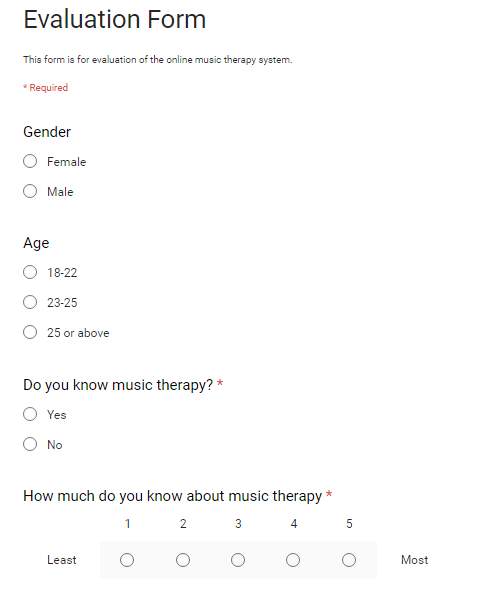
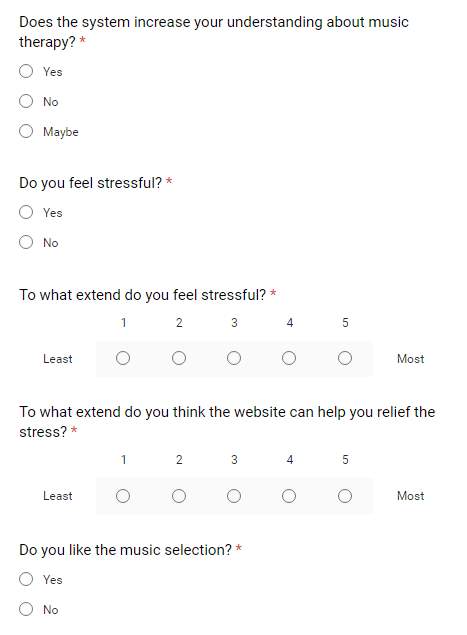
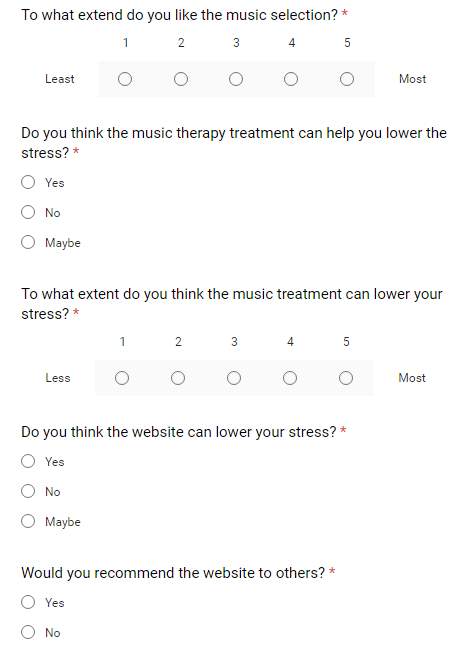
Questionnaire Result
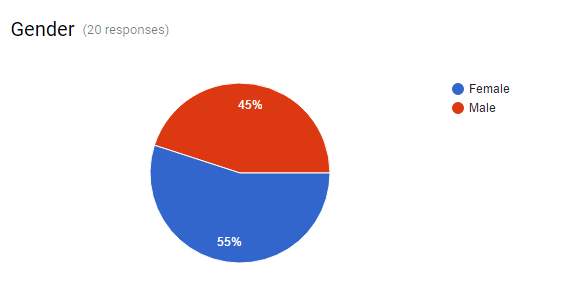
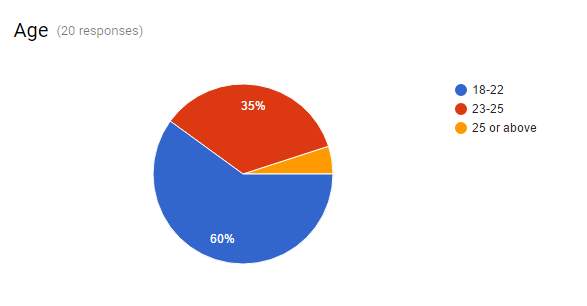
Browser Testing
Firefox 50
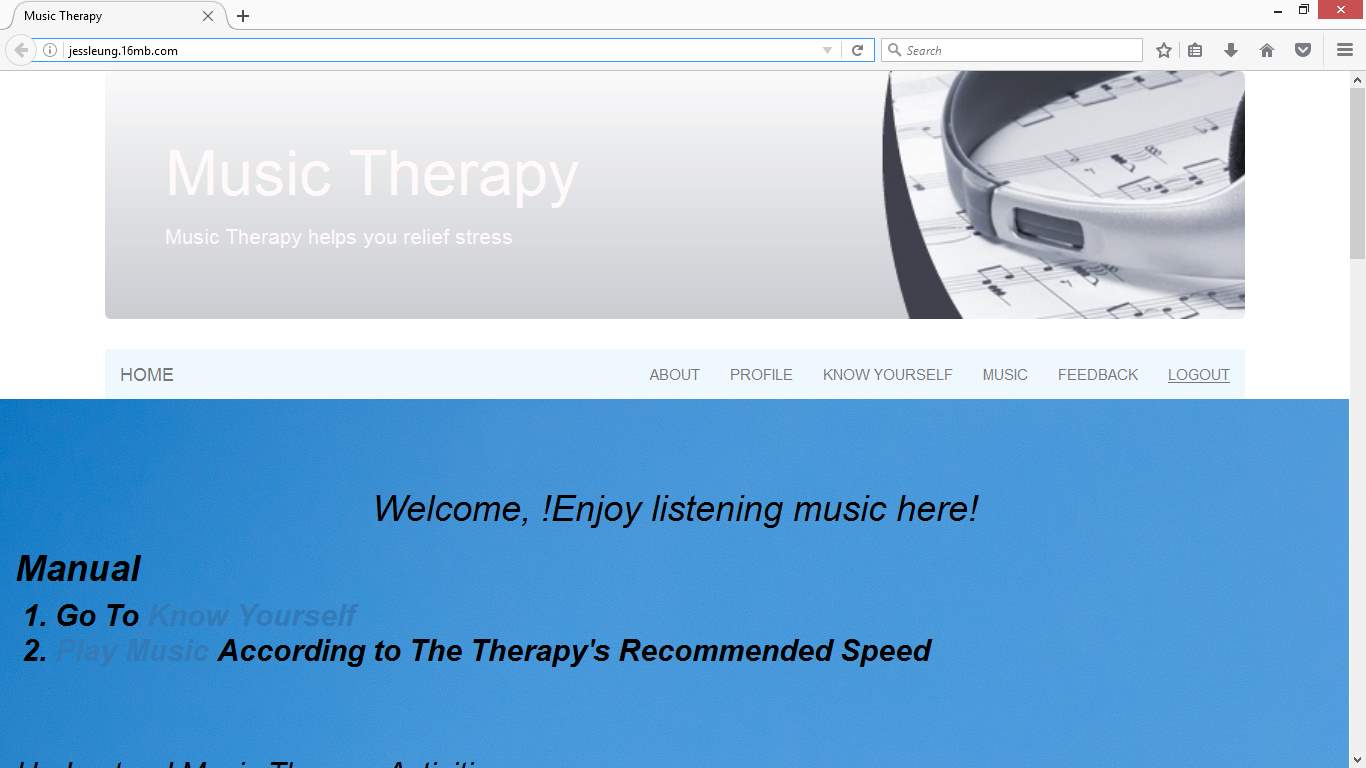
Google Chrome 56
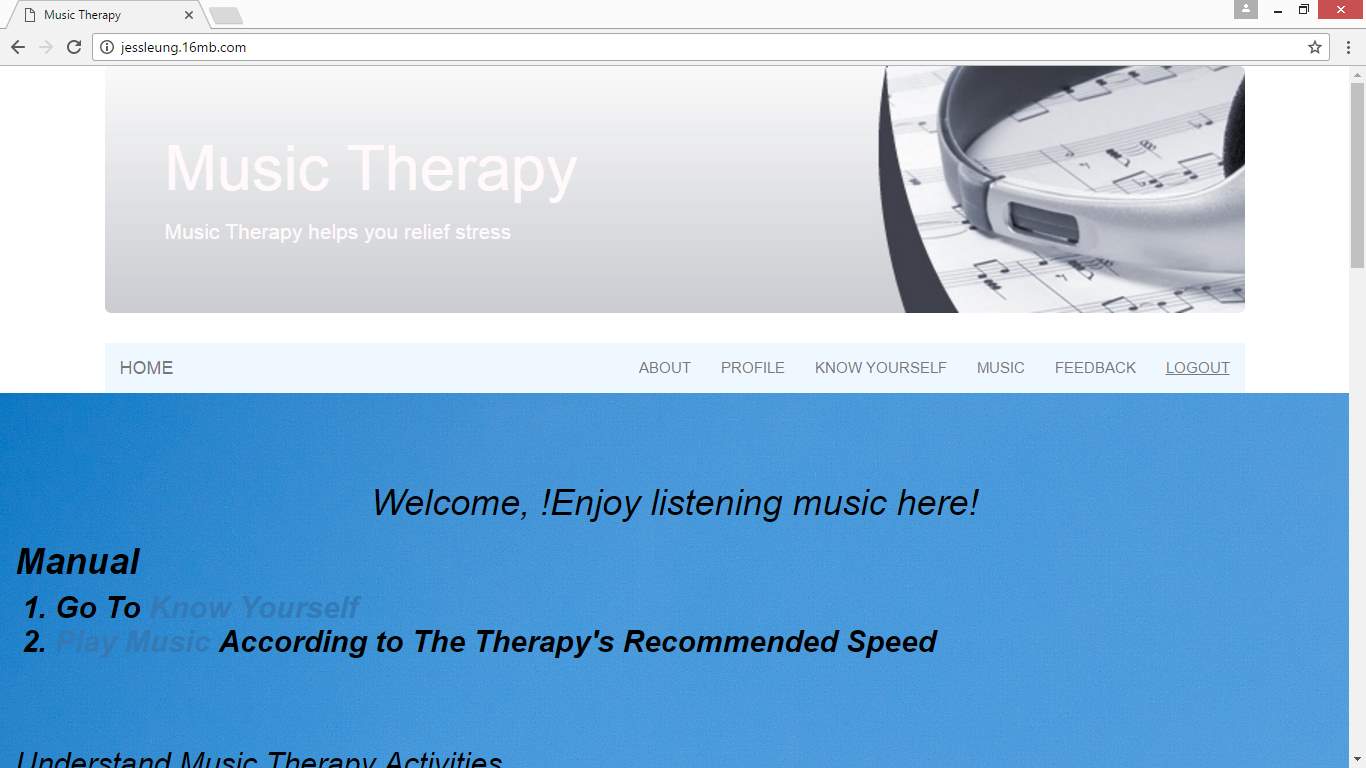
Google Chrome 57
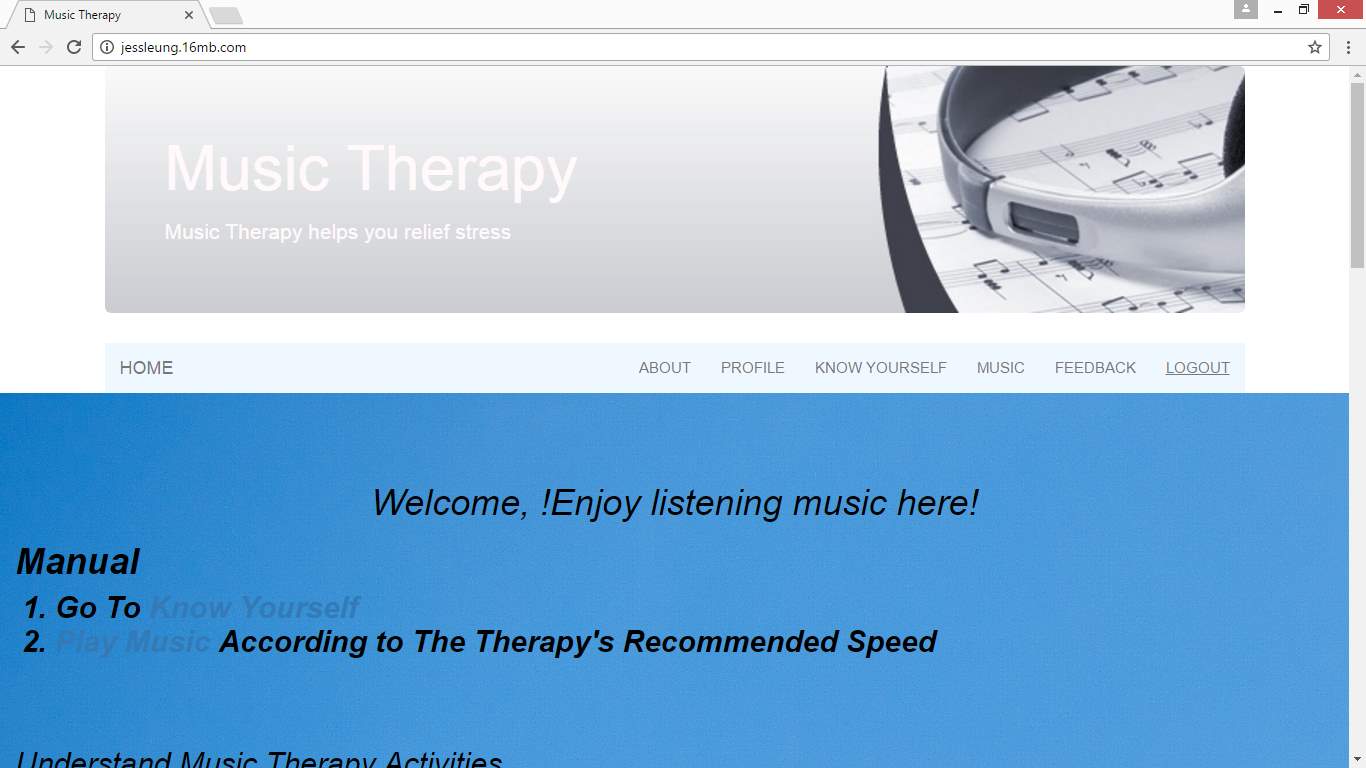
Google Chrome 57.1
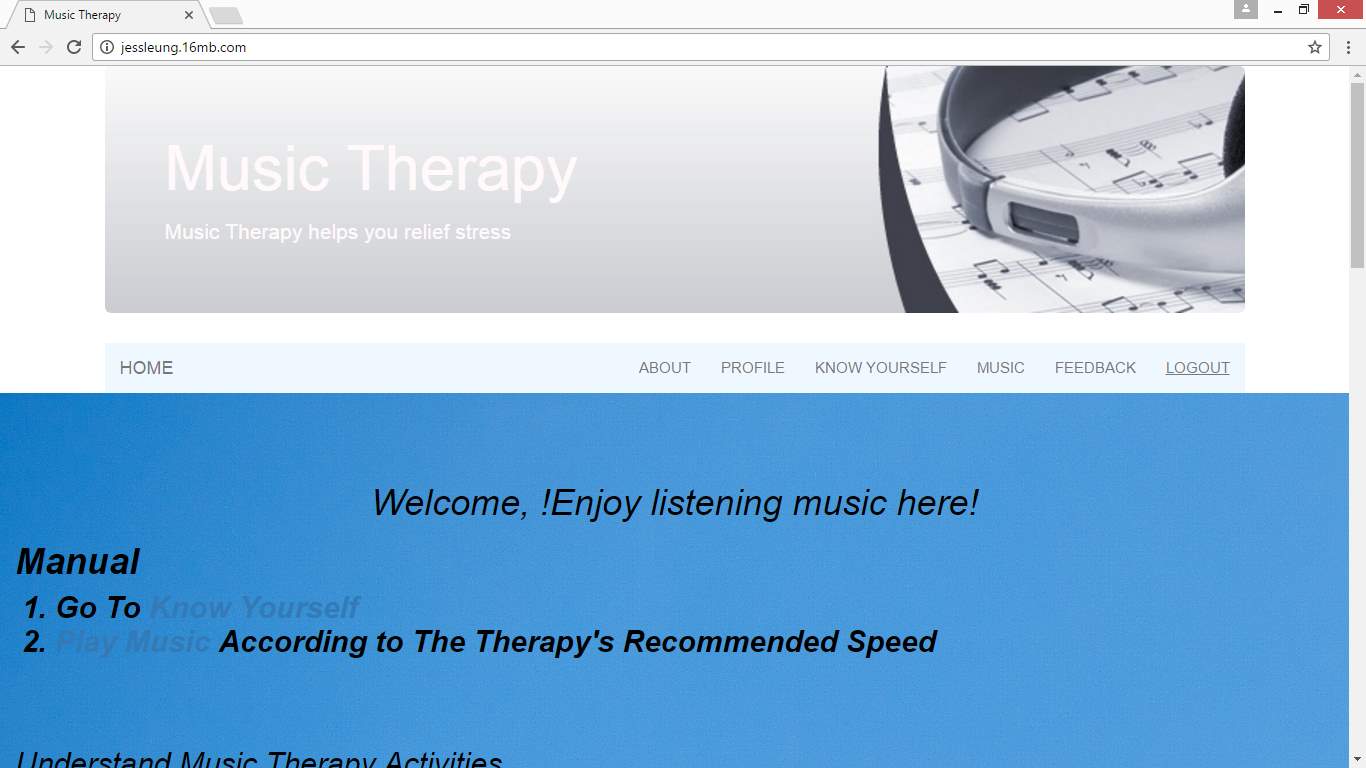
Safari 5.1

Cite This Work
To export a reference to this article please select a referencing stye below:
Related Services
View allRelated Content
All TagsContent relating to: "Psychology"
Psychology is the study of human behaviour and the mind, taking into account external factors, experiences, social influences and other factors. Psychologists set out to understand the mind of humans, exploring how different factors can contribute to behaviour, thoughts, and feelings.
Related Articles
DMCA / Removal Request
If you are the original writer of this dissertation proposal and no longer wish to have your work published on the UKDiss.com website then please:



